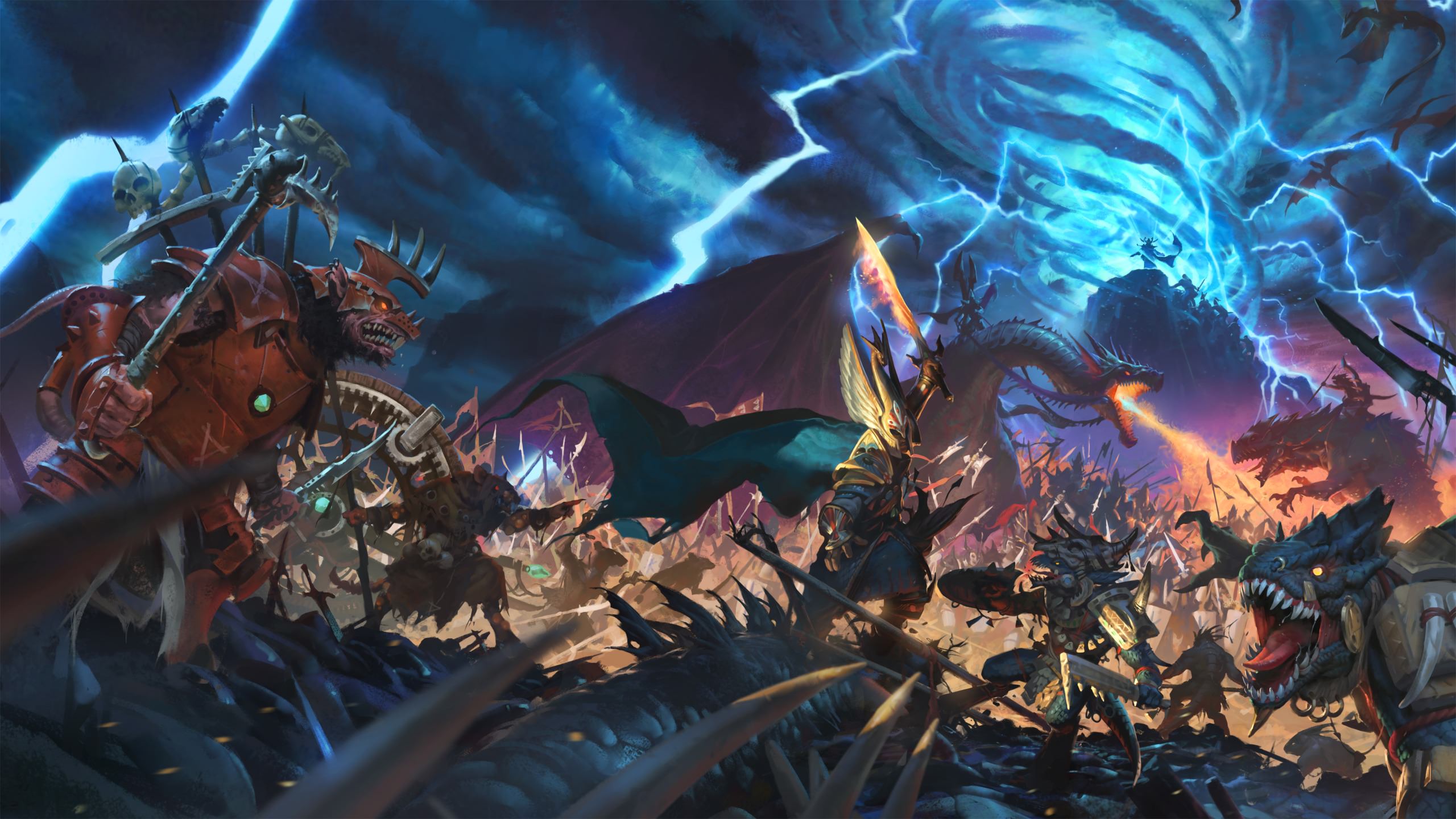
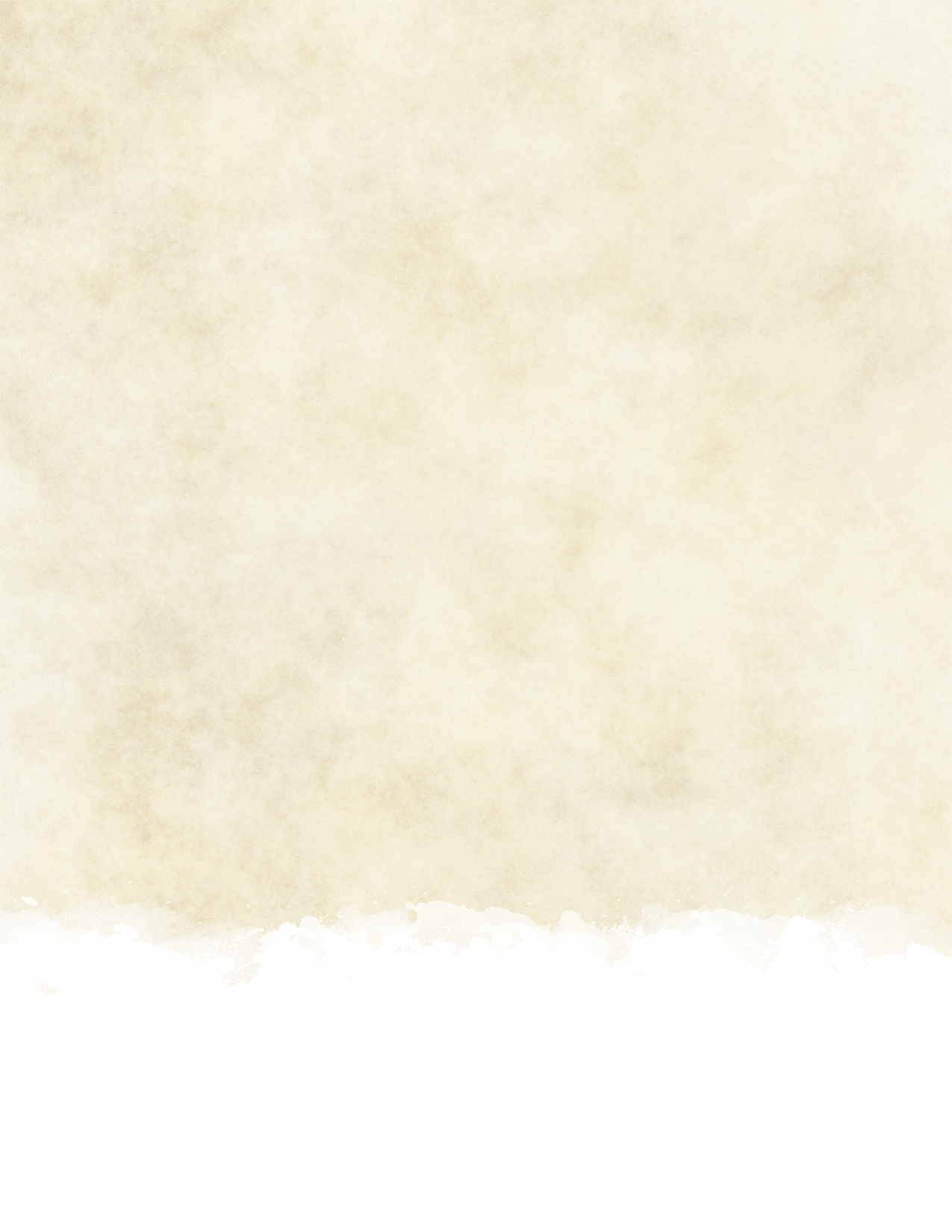
Contents
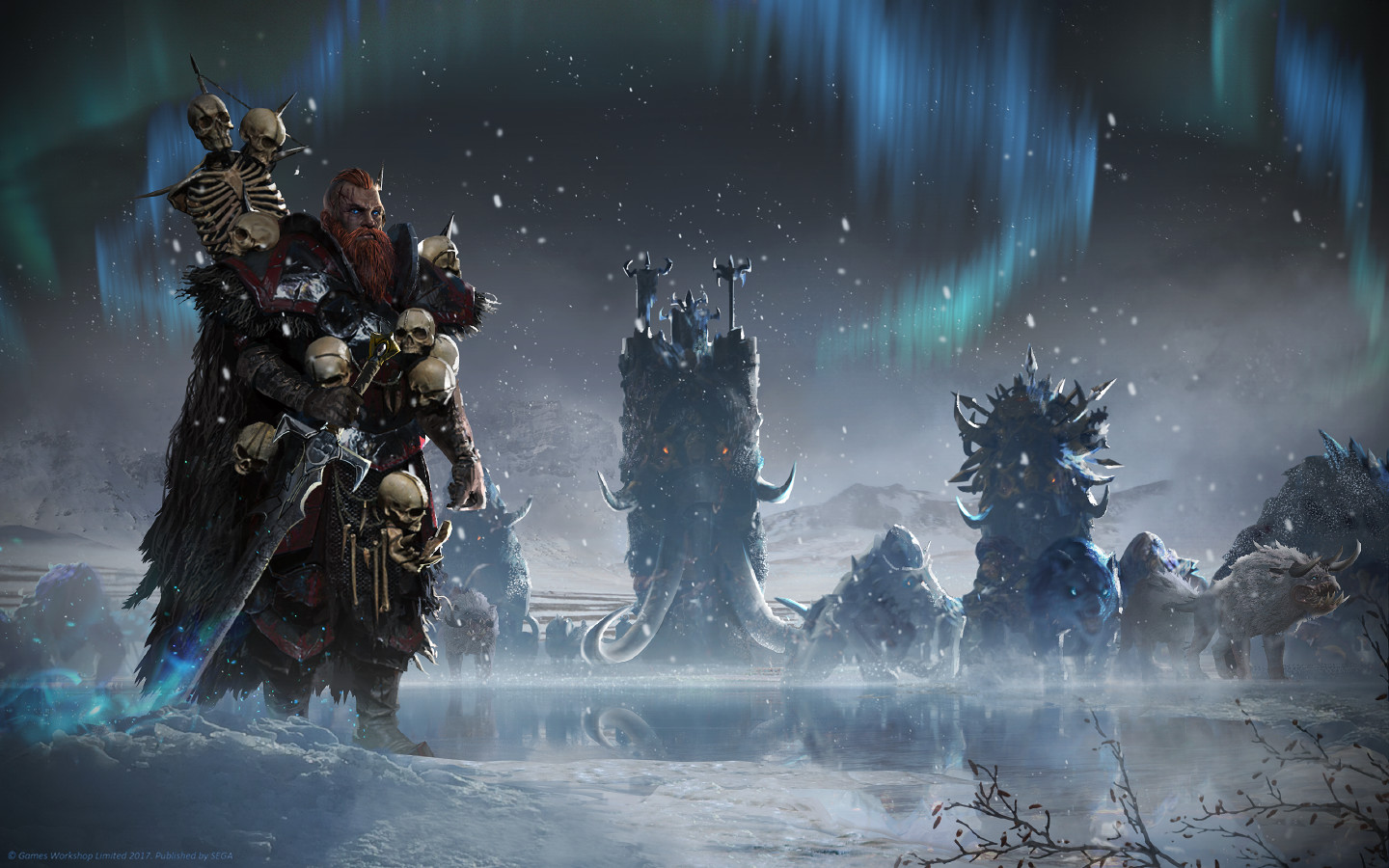

Chapter 2
Norsca
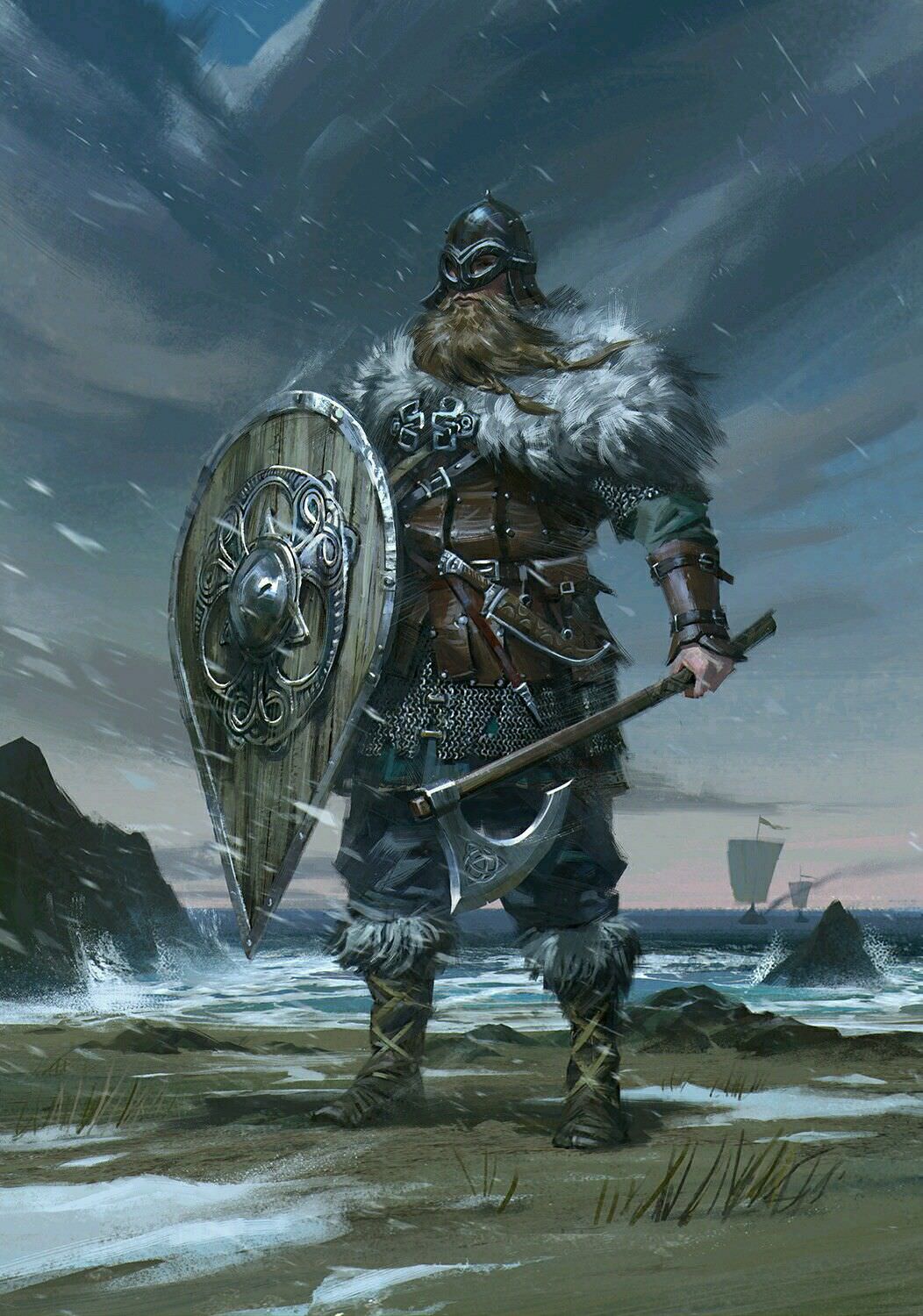
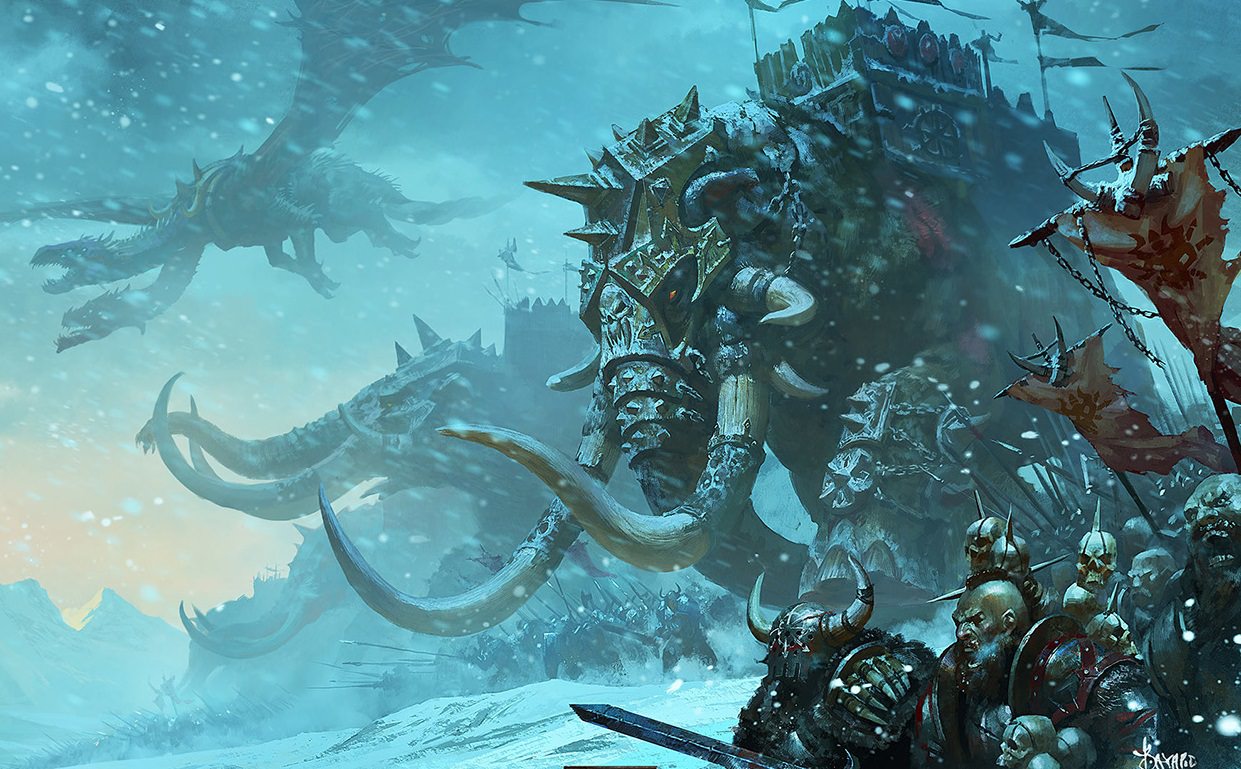

Norsca
Norsca is inhabited by a race of savage and ferocious humans known as the Norscans; fur-clad warriors and berserkers of hairy brawn who sail the seas in fearsome longships in order to unleash their devastating fury upon the south. Warlike and cruel, the Norse are the very epitome of the Warriors of Chaos; fanatically devoted champions of the Dark Gods and the baneful scourge of their foes. The brutality of their raids have been felt as far abroad as the Witch King's baleful domain of Naggaroth and the mysterious realm of Cathay, for the men of Norsca are reckoned to be perhaps the most adept sailors and navigators in all the world; unequaled by any in their courage and reckless thirst for conquest. The Norsemen are, without exception, great warriors, blessed with incredible strength at arms and fearsome demeanors. It is the dream of nearly every member of this fierce people to ascend to the ranks of the greatest warriors; to become mighty Champions of Chaos and bear the dread marks of their gods' ruinous favor.
Landscape. Norsca is a savage and brutal land, plagued by lethal winters for more than half the year, and worse, lashed perpetually by raging gales of Chaos energies howling down from the ancient ruins of the fallen Warp Gate resting at the very heart of the northern Chaos Wastes. As such, no sane Human being would be able to survive in this harsh wasteland with their sanity intact. It is for this reason that most, if not all the tribes of the Norsca, are affected to some extent by the power of Chaos, causing their flesh to warp and mutate through the influences of their Gods, and their minds to be plunged into the darkest depths of the most violent insanity. The Norscans see these alterations as the "blessings" of their dreadful deities, which empower them to strive above and conquer all who oppose them. Hard bitten and war like, the men of Norsca are the greatest of all the warriors of the Dark Gods.
Tribes. The Norscans as a single, cohesive people do not exist. Indeed, the very term 'Norscan' is an Imperial labeling. They are instead divided into various, numerous tribal confederations that are as much at war with each other as they are with the Kurgan and Hung tribes to the East or the Empire to the South. These various Norse tribes are often nations unto themselves: possessing varying pantheons of gods, traditions, heroes and tribal dialects. Those tribes living within the northern reaches of Norsca are often fierce worshipers of Chaos, and are the most common to take part in the Chaos Gods' wars upon the civilised world. The southern tribes are somewhat milder than their northern counterparts. While they raid and plunder just as much as the rest of their kin, it is from these tribes that the ideals of trade and cooperation have begun to take root, albeit shakily. When not waging war against the southern realms, these tribes often trade exotic furs, metals, and their service as mercenaries to employers in cities such as Marienburg. However, all Norse are united by a shared ancestry and a mutual veneration of the Four Dark Lords of Chaos, and as such, when the Gods speak and command war to be made against the Empire, the southern tribes take up the call as readily as their more northerly kinsmen. To refuse the call of the gods is the greatest dishonor a tribe can bring unto itself, and is often seen by other Norscans as grounds for annihilation
Norscans' High Tribes
The nine 'High' tribes of Norsca, from which all others descend:
- Aeslings
- Graelings
- Vargs
- Sarls
- Bjornlings
- Skaelings
- Baersonlings
- Hastlings
- Kvelligs
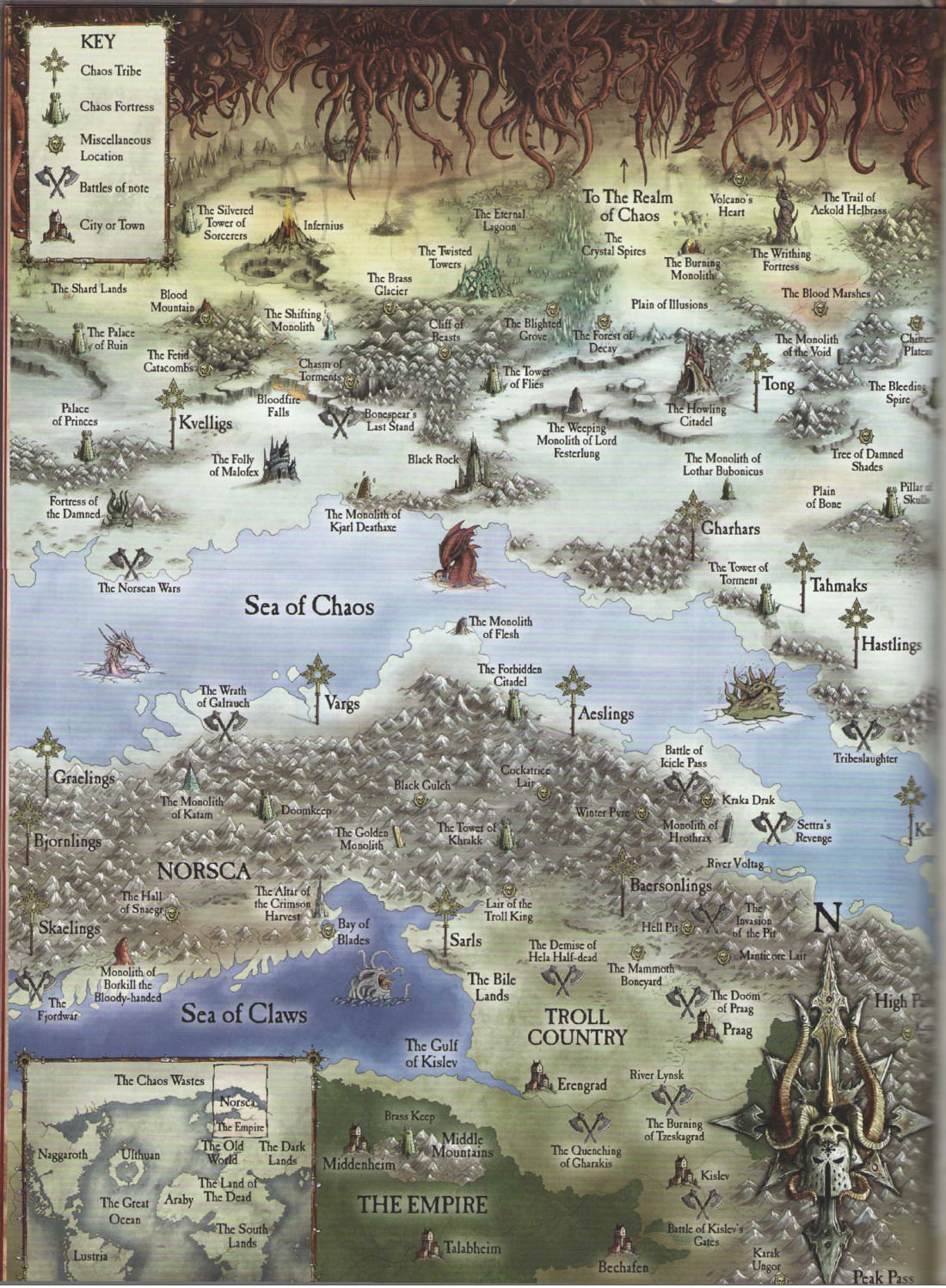
Heretic Religion
Norscan religion is based primarily around the worship
of the Chaos Gods, which are venerated by various local aspects and names both similar to and distinct to those they are known by to the scholars and priests of the Empire. Commonly, the Norscans, like the other human races who dwell around the Chaos Wastes, venerate all
the Chaos Gods in a single pantheon, as a purely
practical consideration in order to draw upon all of the
gifts and powers of the Four Gods in order to better
survive in the harsh north. In spite of this, there are
many tribes that do in fact take a single Chaos God to be their patron, who is then seen as both the father and protector of that tribe. Commonly, that god is also the Patron of the chieftain. In the vast majority of Norse
tribes, Khorne takes up this position, as he is by far the most popular choice of patron deity in the battle torn North.
In addition to the Chaos Gods themselves, the
Northmen religion also incorporates various Daemon Princes, fallen Chaos Champions, revered ancestors and various other lesser spirits into its traditions. Despite the presence of these additional deities however, it is always the Chaos Gods alone are ever present and who receive the highest degree of veneration; being the core set of deities Norse religion revolves around.
The Norsemen have worshiped the Dark Gods since times immemorial; the tribes simply have no concept of how to live otherwise. Far from being mindless slaves to darkness, the men of the North merely maintain that beings as powerful as the Chaos Gods simply operate on a level beyond mere human judgement or understanding, and are thus entitled to reward or destroy as befits their divine inclination. Just as it is the charge of a man to pay them homage and passionately strive for their favor. The Norsemen believe the path they have taken is the only one that is pure and true, and thus look down upon the gods of the southern lands; seeing them as corrupt, weak and wicked things that are beneath contempt and worthy only of mockery.
Afterlife. In the Norscan faith there is no equivalent to the Kingdom of Morr, there is nothing after death save the Realms of the Dark Gods, and men shall only enter those domains to sit at the right hand of their gods if they were strong and true warriors in life. For cowards are cursed by the gods and reviled for all eternity. Thus, every Norscan fights with an insane fervor driven by this belief, which molds them into the perfect warriors of the Dark Gods.
The Ruinous Powers:
In battle the Norse look to Khorne, the War God, for strength. The Blood God is renowned in Norscan sagas as an embodiment of strength and a granter of victory, and so thousands upon thousands of Norse warriors are dedicated to his savage creed of wanton bloodshed.
Seers and Vitki take Tzeentch, the Raven God, as their patron, and beseech the Changer of the Ways to aid them in their witchery and to one day grant them pre-eminence over the warrior kings who lead the tribes. As most Norscan spellcasters are Chaos Sorcerers of a sort, channeling the Black Wind of Dhar to power their profane divination, it is common for them to take at least one or more of the Dark Gods as their patrons, and most commonly this patron is Tzeentch, due to his association with magic and sorcery. For the most part however, Tzeentch is distrusted by most Norscans, particularly warriors, for his cunning ways, yet as he is also seen as the god of wind and tide, most Norscans will strive for his favor before taking to their longships, in order to ensure a safe voyage.
In times of plague and famine, the Norse offer sacrifices to Nurgle, to placate the Crow God and to persuade him to withhold his "blessings." Some tribes dedicate themselves to the Plague Father in such occasions, however, believing that only through fighting in his name shall they be delivered from the ruinous touch of Nurgle's contagions.
Slaanesh, the Great Serpent, is prayed to in the aftermath of battle for fulsome feasting and celebration. He is also prayed to for fertility and virility and is invoked in some tribes' marriage ceremonies.
There is also a very strong element of ancestral worship to the Norse religion that cannot be overlooked. Indeed, the veneration of the ancestors is a tradition as old as the worship of the Chaos Gods themselves to the Norsemen, and one from which they too derive their strength and fierce codes of honor.
Marauders
Chaos Marauders are the most numerous tribal warriors dedicated to the worship of Chaos, and whose profession for violence and savagery have since earned them the well known title of Marauders by the inhabitants of the Old World, though amongst their own people, they are simply known as warriors, and in times of peace, they often serve the clans as guardians and hunters. As befit their barbaric reputation, these axe wielding barbarians often charge into the fray within great howling mobs without care for armor or tactics. They have little fear of dying in combat, for to fight and die under the gaze of their gods is considered the greatest death one can achieve in their lifetime.
Marauder
Medium humanoid, chaotic evil
- Armor Class 15 (shield, hide)
- Hit Points 28 (5d8 + 5)
- Speed 9m.
STR DEX CON INT WIS CHA 14(+2) 12(+1) 13(+1) 8(-1) 11(+0) 9(-1)
- Senses passive Perception 10
- Languages Common
- Challenge 1/2 (100 XP)
Shield Wall. Three or more marauders close together in a line can form a shield wall. While in this formation each marauder has advantage on Athletics checks and Strength saving throws, an AC of 20 and is considered behind half cover for ranged attacks from the front of the shield wall.
Actions
Battleaxe. Melee Weapon Attack: +4 to hit, reach 1,5m, one target. Hit: 6 (1d8 + 2) slashing damage.
Warriors of Khorne, Nurgle, Tzeentch, Slaanesh variants:
The Norsemen usually pledge themselves to one of the Ruinous powers in exchange of their blessings to enhance their martial prowess. To quickly build one of these variants pick the normal template of the desired warrior and add the blessing of their god
- Mark of Khorne: Creatures blessed by Khorne may make one additional melee attack as part of their attack action and score critical hits on a roll of 19 or 20. They also have advantage on Athletics checks and Strength saving throws.
- Mark of Tzeentch: Creatures blessed by Tzeentch have advantage on Intelligence checks and Int/Wis/Cha saving throws against spells and other magical effects. They can also choose a number of cantrips from the wizard spells list, equal to half their CR rounded down, that they know and can cast at will. Finally any spells cast by the blessed deal one additional die of damage, e.g 3d6 becomes 4d6.
- Mark of Nurgle: Creatures blessed by Nurgle have advantage on Constitution saving throws, resistance to bludgeoning, piercing and slashing damage from nonmagical sources and are immune to diseases and poison damage. In addition their maximum hit points are equals to those of the original template multiplied by 1,5.
- Mark of Slaanesh: Creatures blessed by Slaanesh have advantage on Wisdom and Charisma saving throws, and creatures have disadvantage on saving throws to resist charm effects from the blessed. In addition their maximum speed is increased by a factor of 1,5.
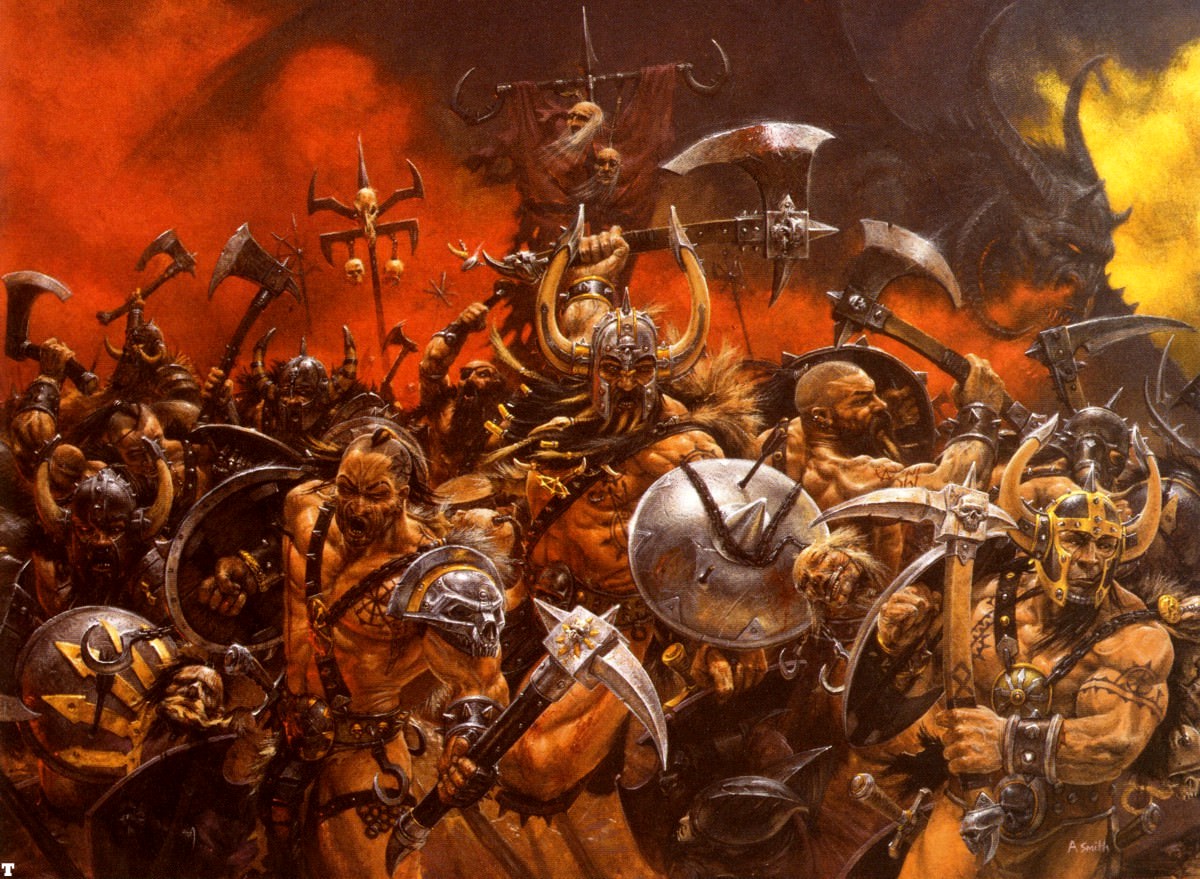

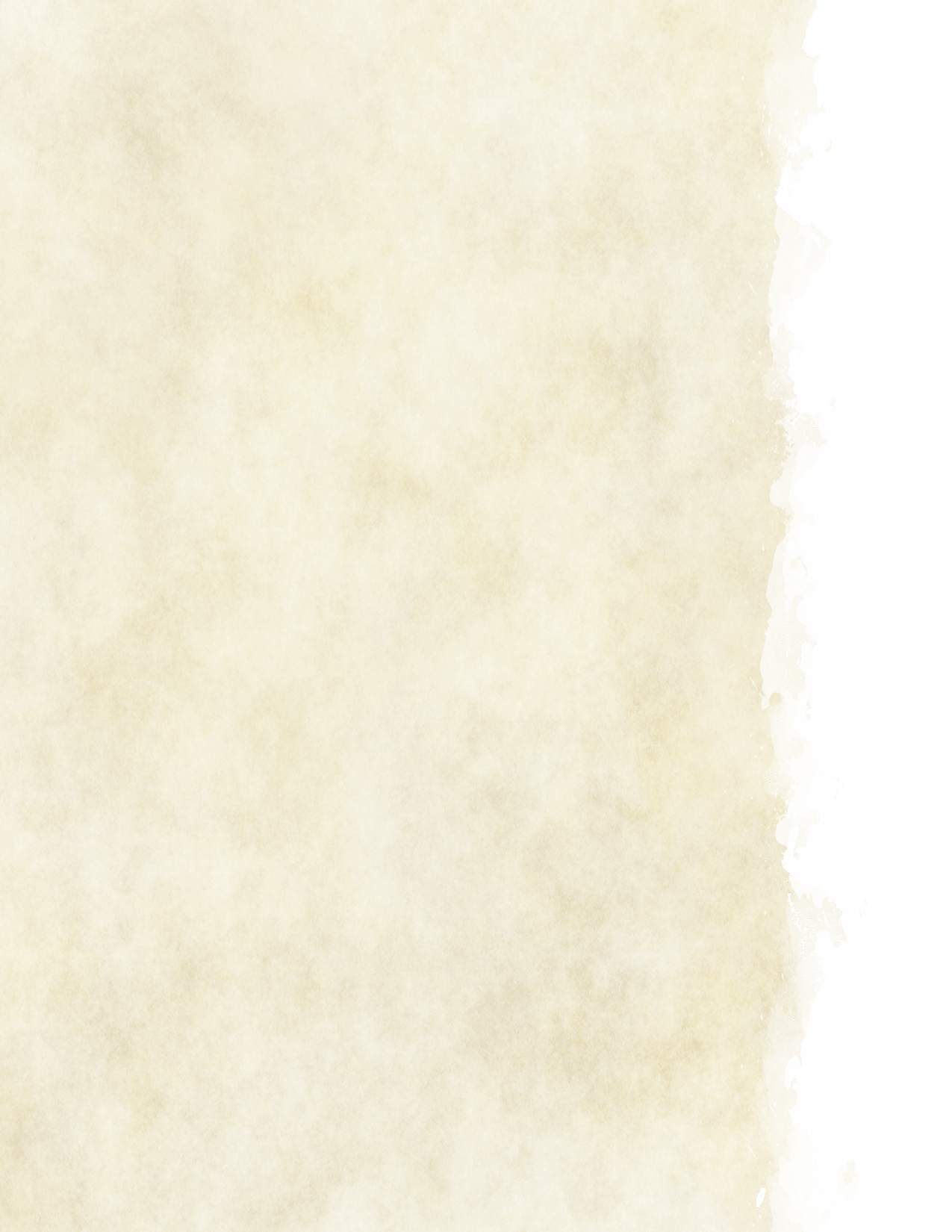
Berserkers
Marauder Berserkers are a brutal sect of Northmen warriors. They are known chiefly for being subject to terrifying battle frenzies that render them immune to pain and which transform them into unstoppable juggernauts on the field of battle. Their feats fill the songs of the Skalds and loom large in the sagas of the North and the nightmares of Imperial soldiers who have faced them on the battlefield. Bred from the hardiest stock of the already hardy folk of the grim northlands, the berserkers of Norsca are a rightly feared warrior cult. Though many berserkers wear armor, others purposely go into battle without protection in order to display the bravery to their foe, to their kinsmen, and to their Dark Gods. They are possessed of a dark, brutal madness which compels them to fight on until they have slaughtered all about them, or are themselves slain.
Berserker
Medium humanoid, chaotic evil
- Armor Class 12
- Hit Points 52 (8d8 + 16)
- Speed 12m.
STR DEX CON INT WIS CHA 16(+3) 14(+2) 15(+2) 8(-1) 10(+0) 13(+1)
- Skills Athletics +6, Intimidation +6
- Condition Immunities frightened
- Senses passive Perception 10
- Languages Common
- Challenge 2 (450 XP)
Fury (1/day). When the berserker is reduced to 0 hit points, but not killed outright, can drop to 1 hit point instead.
Retaliation. When the berserker takes damage from a creature that is within reach, it can use its reaction to make a melee weapon attack against that creature.
Rage (1/day). As a bonus action the berserker can enter into a frenzy rage that lasts for 1 minute and grants the following benefits:
- Advantage on Strength checks and saving throws.
- +2 bonus to damage rolls with melee weapon attacks.
- Resistance to bludgeoning, piercing, and slashing damage.
Actions
Multiattack. The berserker makes three attacks with its twins battleaxes.
Battleaxes. Melee Weapon Attack: +6 to hit, reach 1,5m, one target. Hit: 7 (1d8 + 3) slashing damage.
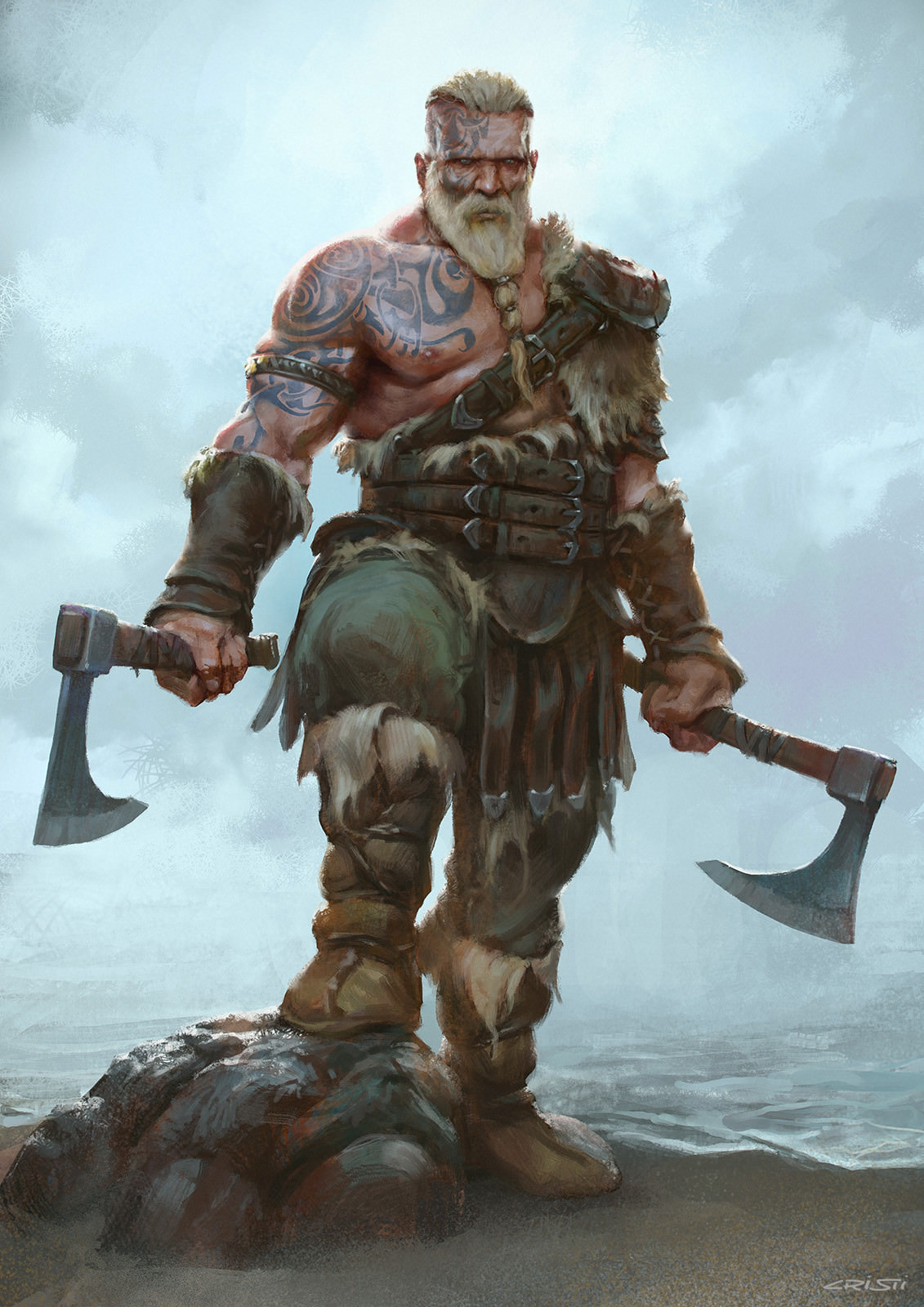


Reavers
Norscan Reavers are warriors amongst the Norscans whom have taken to piracy and raiding as a means of living. The seas of the Old World are full of terrors, some Human, others subhuman. Among the most feared mariners are the Norse Reavers, brutal warriors who plunder the coastlines in search of foodstuffs, gold, and slaves. They are a merciless lot, hardened from their frequent battles with Imperial sailors and the feeble militias that stand against them. Reavers sail the seas to bring booty back to their settlements in their frozen lands. Others sell their souls to the Ruinous Powers, hoping to attract the attention of their uncaring Gods, and gain the power they so crave.
Reaver (Marauder variant).
A Reaver is a CR 1/2 (100 XP) warrior with the stats of a marauder but with the following changes:
- It has the Mariner trait: The reaver can hold its breath underwater for twice as long and has proficiency with navigator's tools.
- It has an AC of 17 (scale mail) and a variety of weaponry and equipment based on the places it plundered and looted.
Kings
The most powerful and fearsome of Norsemen are the dark Kings of this wild land. There is a divide in the methods of royal succession between the northern and southern parts of Norsca. In the North, Kings are invariably victors of blood drenched trials by combat where all claimants battle each other in order to determine who among them is the greatest warrior and most favored by the Dark gods. In the South, however, the transition of power is generally somewhat smoother, but still fraught with violence as the new King must still slay his rivals in combat to ensure his power and prove his worthiness before both the gods and his kinsmen. All Kings of Norsca bear upon them Marks of the Dark Gods, indicating outwardly that they have been blessed by their patron deities with incredible power and might. These Marks are also an indication of the King’s right to rule, for he must have already proven himself as a mighty warlord in order to attract the Eyes of the gods in such a profound way. Celebrated Chaos Champions, the Kings of Norsca are amongst the most deadly warriors in the entire world, and prove the legends of their dark might in war time and time again. At times, certain exceptionally powerful Kings can rise to unite multiple tribes or even all of Norsca under their banners. This individual is known as the High King. To date, there have only been a small number of individuals with the sheer strength and will required to become High Kings, such as High King Ormgaard, High King Valmir Aesling, and High King Erik Redaxe.
King
Large humanoid, chaotic evil
- Armor Class 22 (shield, medium chaos armor)
- Hit Points 252 (24d10 + 120)
- Speed 9m.
STR DEX CON INT WIS CHA 24(+7) 16(+3) 21(+5) 16(+3) 12(+1) 19(+4)
- Saving Throws Str +12, Con +10, Cha +9
- Skills Athletics +12, Intimidation +9, Perception +6
- Condition Immunities exhaustion, frightened
- Senses passive Perception 16
- Languages Common
- Challenge 16 (15000 XP)
Legendary Resistance (3/day). If the King fails a saving throw, it can choose to succeed instead.
King's will. The King has advantage on Wisdom saving throws.
Champion of the Dark Gods. The King has a mark from one ore more of the Ruinous Powers that grants it their blessing. In addition all the King's attacks are considered magical for the purpose of overcoming damage resistances.
Fury of Chaos. Once per turn, the King can deal an extra 18 (4d8) chaotic damage to a creature it hits with a weapon attack. If this attack brings the creature below 0 HP, one random limb is cut off and the target must succeed on a Constitution saving throw (DC=14) or develop one chaos mutation. A natural 1 on the saving throw transform the creature into a Chaos Spawn.
Actions
Multiattack. The King can use its battlecry if available and then make four attacks.
Longsword of Chaos. Melee Weapon Attack: +12 to hit, reach 1,5m, one target. Hit: 18 (2d10 + 7) slashing damage plus 5 (1d10) chaotic damage.
Shield Bash. Melee Weapon Attack: +12 to hit, reach 1,5m, one creature. Hit: 14 (2d6 + 7) bludgeoning damage. If the target is Large or smaller, it must succeed on a DC 17 Strength saving throw or be knocked prone.
Battle Cry (Recharge 5-6). Each creature of the King's choice that is within 12m of it, can hear it, and not already affected by Battle Cry gains advantage on attack rolls until the start of the King's next turn. The King can then make one attack as a bonus action.
Legendary Actions
The King can take 3 legendary actions, choosing from the options below. Only one legendary action option can be used at a time and only at the end of another creature's turn. The King regains spent legendary actions at the start of its turn.
Shove. The King can attempt a shove attack to push up to 3m one creature within melee range.
Charge. The King moves and performs one melee attack.
Demonic Blast (Costs 2 Actions). The King hurls an orb of green demonfire in a 30m range that explodes in a 3m radius. Each creature in the area of effect must make a Dexterity saving throw (DC=14). On a failure the creature suffers 4d6 fire damage plus 4d6 chaotic damage, or half as much on a successful one.
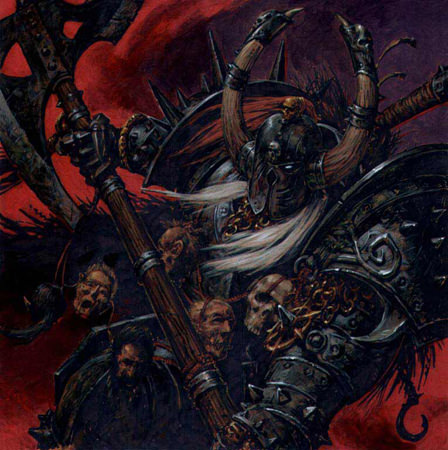


Skin Wolves
Skin Wolves are Werecreatures of Chaos that turn into lycanthropes. Many are the foul Chaos cults and many are the dark horrors of twisted flesh and nightmares made real that the Ruinous Powers have visited upon the world. Few, though, are as strange as the skin wolves of legend. In the far north, among those who dwell in the shadow of Chaos, be they Norscan, Kurgan or Hung, as well as the shunned corners of the world where degenerates root and fester such as the Bone Hills of Estalia or the dire fens south of the Badlands, myths and bloody tales speak of the skin wolves. Witch cursed or Chaos tainted, these men and women, half feral and subject to savage appetites, carry within them a taint in the blood, a mutation that shows not readily as stigmata on their flesh, but slumbers within, a beast waiting to be unleashed by blood and unspeakable ritual.
When this horror is released, no mere transformation of man into beast is effected. Instead the humanoid wolf thing, lean and half insane with insatiable hunger, rips its way fully formed from the body of the man, which is left little more than shredded flaps of skin and chunks of bloody gristle by the freeing monster. It is the clinging shrouds of skin that give the beasts their common name. The frenzied creatures, whose packs are formed by kinship ties of blood and slaughter, care not what they kill in their bloodlust and bear no loyalty to any master, save the Dark Gods themselves. As such, only the most unscrupulous wizard would seek to bind them to their will by Kadon's magic, and some that have done so have had cause to lament their choice of ally. Only once battle is spent and a skin wolf has glutted itself on the raw and dripping gore of its enemies will the terrible transformation be reversed and the bubbling and overworked flesh of the skin wolf collapse, then like a newborn the human must tear its way out of the monster it once was. All skin wolves have the ability to regenerate their horrid forms and they may carry the favor of one of the Chaos Gods.
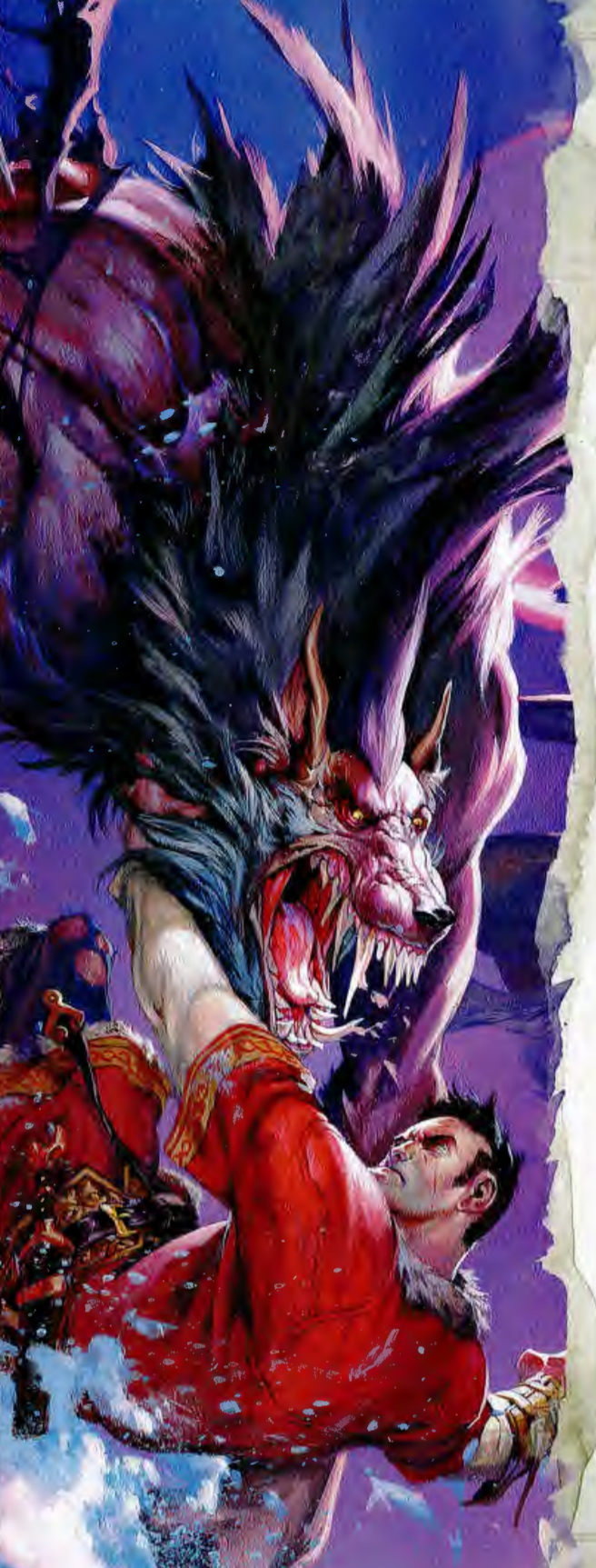


Ernst Wolfenburg, Mercenary:
“I’d heard tales of the Norse Berserkers and their ways, but not one story prepared me for facing them on the field of battle. The Kislevites I’d taken up with were some of the strongest and most taciturn warriors I’ve ever had the honor of serving alongside, so I was somewhat surprised when I found out that they were quietly nervous about the morrow’s engagement. We were all set to fight a raiding band from a tribe called the Baersonlings. I didn’t really believe even half of what the Kislevites told me. But the following morning, I stood on the edges of the northern pack ice and watched the fur clad barbarians chew on their shields, some of them while foaming at the mouth. That was endurable, I’d seen stranger in my travels. But as the battle began, as their features melted and twisted, the muzzles of wolves emerging from beneath their helms, claws unsheathing from their flesh, I knew why the Kislevites feared the Norsemen. It was a long struggle and I’ll not pretend it was an easy victory, but as fierce as they were, the Chaos touched bastards fell in the end as any other men.”
Skin wolf
Medium humanoid (human, shapechanger), chaotic evil
- Armor Class 14 (natural armor)
- Hit Points 135 (18d8 + 54)
- Speed 12m.
STR DEX CON INT WIS CHA 19(+4) 17(+3) 16(+3) 4(-3) 15(+2) 8(-1)
- Saving Throws Str +7, Dex +6
- Skills Perception +5, Stealth +6
- Damage Immunities bludgeoning, piercing, and slashing damage from nonmagical weapons that aren't silvered
- Senses darkvision, passive Perception 15
- Languages Common
- Challenge 6 (2300 XP)
Keen Hearing and Smell. The skin-wolf has advantage on Wisdom (Perception) checks that rely on hearing or smell.
Painful Transformation. The beast literally tears its way out of the skin of its human form. When transforming the skin-wolf takes two claws attacks to itself.
Bloodgreed. The skin-wolf has advantage on attack rolls against bloodied creatures (creatures that can bleed and that are under half HP).
Actions
Multiattack. The skin-wolf makes three attacks: one with its bite and two with its claws.
Bite. Melee Weapon Attack: +7 to hit, reach 1,5m, one target. Hit: 13 (2d8 + 4) piercing damage. Claws. Melee Weapon Attack: +7 to hit, reach 1,5m, one target. Hit: 11 (2d6 + 4) slashing damage.
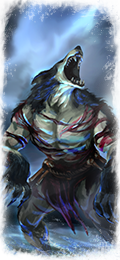
Fimir
The Fimir are amphibious humanoid monsters that haunt bogs, fens and desolate moorlands throughout the northern and western Old World. Their strongholds take the form of forbidding, craggy piles of rock, crudely built in the semblance of the castles of more civilised races. Such dwellings are seldom seen by outsiders, for they are wreathed in thick mist, a miasma which is magically generated by the Fimir to shield their fortresses from prying eyes, and themselves from the harsh glare of the sun.
Long before the rise of Man, the Fimir worshiped the Chaos Gods, and for a time enjoyed their favor. Alas, the Eye of the Gods was swiftly drawn to the more vibrant and amusing race of Man, and the Fimir were abandoned, reduced to seeking boons from bound Daemons where once they had enjoyed the blessings of gods. Nowadays, the Fimir are a dwindling and reclusive race, little given to leaving their swampy fastnesses, save for the occasional raid for food and slaves. Only the Fimir sorcerers, known as Dirach or sometimes as Balefiends, spend prolonged periods in the lands beyond the mists. Such creatures have but one goal, to destabilize the barrier between the mortal world and the Realm of Chaos, thus aiding the Chaos Gods to their ultimate victory, and so regaining their favor.
Sorcerers. A Balefiend's sorceries seem crude and ritualistic compared to the magic of Elves or even Men, but they are no less potent, for they are woven with power stolen from Daemons. A Balefiend's cyclopean eye can see the ebb and flow of the Winds of Magic in the same way a Man's perceives light and shade, which allows them to make the best use of whatever magical power is available.
Warriors. Fimir Warriors are the footsoldiers of their race, bedecked in large, powerful plate armor and wielding clumsy maces into battle. To isolated and lonely settlements on fog shrouded fen and swamp, from the hinterlands of the Empire to the edges of far Cathay, the Fimir are a creature of horrific legend made manifest. Cold and cruel and mightier than any man, with a single baleful eye atop a pointed snout bristling with jagged fangs, to some these scaled nightmares are daemons incarnate, but the truth is much stranger and darker.
Once when all the world was fog shrouded and dark, legend has it that these cyclopean fiends ravaged the Old World in mighty warbands, tearing down the cities of the High Elves and struggling in blood conflict with the wild men who dwelt in the lands that would millennia later become the Empire long before Sigmar arose there.
Now the dwindling Fimir, degenerate and malign, are reduced to plotting petty raids within their forlorn strongholds and nursing bitter hatred for those that now rule where once they were masters. Larger and more ferocious than their sorcerous Dirach brethren, with tails tipped with huge bony clubs, the Fimir are mighty warriors, their deathly yellow-grey flesh all but immune to pain so that each can shrug off bows that would kill a man outright. They now march forth from the few remaining hidden Fimir holds under dense blankets of fog; summoned and controlled by primitive talismans forged in blood and bronze by the Dirach and their foul matriarchs, their goal to tear the warm blooded screaming from their shattered homes and holdfasts.
Fimir Warrior
Large monstrosity, chaotic evil
- Armor Class 22 (natural armor, plate armor)
- Hit Points 153 (18d10 + 54)
- Speed 6m, swim 9m.
STR DEX CON INT WIS CHA 20(+5) 9(-1) 16(+3) 11(+0) 6(-2) 12(+1)
- Saving Throws Con +6
- Skills Athletics +8, History +3
- Damage Resistances cold, piercing and slashing
- Senses passive Perception 8
- Languages Common, Fimirian
- Challenge 8 (3900 XP)
Amphibious. The fimir can breathe air and water.
Hardened Shell. All the damage the fimir takes from behind is halved except for psychic damage.
Poor Depth Perception. The fimir has disadvantage on any attack roll against a target more than 12m away.
Swamp Camouflage. The fimir has advantage on Dexterity (Stealth) checks made to hide in swampy terrain.
Actions
Multiattack. The fimir makes three attacks: two with its heavy maul and one with its spiked tail.
Heavy Maul. Melee Weapon Attack: +8 to hit, reach 3m, one target. Hit: 15 (3d6 + 5) bludgeoning damage.
Spiked Tail. Melee Weapon Attack: +8 to hit, reach 3m, one target. Hit: 16 (2d10 + 5) piercing damage.
Fimir Balefiend
Large monstrosity, chaotic evil
- Armor Class 18 (natural armor)
- Hit Points 135 (18d10 + 36)
- Speed 6m, swim 9m.
STR DEX CON INT WIS CHA 16(+3) 8(-1) 14(+2) 16(+3) 12(+1) 20(+5)
- Saving Throws Con +6, Cha +9
- Skills Arcana +7, Insight +5, Religion +7
- Damage Resistances cold, piercing and slashing
- Senses passive Perception 11
- Languages Common, Fimirian
- Challenge 10 (5900 XP)
Amphibious. The fimir can breathe air and water.
Attuned to the Winds of Magic. The fimir balefiend has advantage on Wisdom (Perception) checks against magical creatures, casters and creatures that carry magical objects.
Poor Depth Perception. The fimir has disadvantage on any attack roll against a target more than 12m away.
Swamp Camouflage. The fimir has advantage on Dexterity (Stealth) checks made to hide in swampy terrain.
Spellcasting. The fimir sorcerer spellcasting ability is Charisma (spell save DC 17, +9 to hit with spell attacks). It knows the following spells:
Cantrips (at will): Dancing Lights, Mage Hand, Message, Prestidigitation, Shilelagh, Shocking Grasp.
Spells (Lore of Spirits): Spirit Staff, Fire of Vengeance, Spirit's Voice, Defeat Disease Spirit, Message of Doom, Spirit Shield.
Actions
Quarterstaff. Melee Weapon Attack: +7 to hit, reach 1,5m, one target. Hit: 7 (1d8 + 3) bludgeoning damage.
Summon Spirits (1/day). The balefiend summons 1d4 ghosts to aid him in battle for one minute.
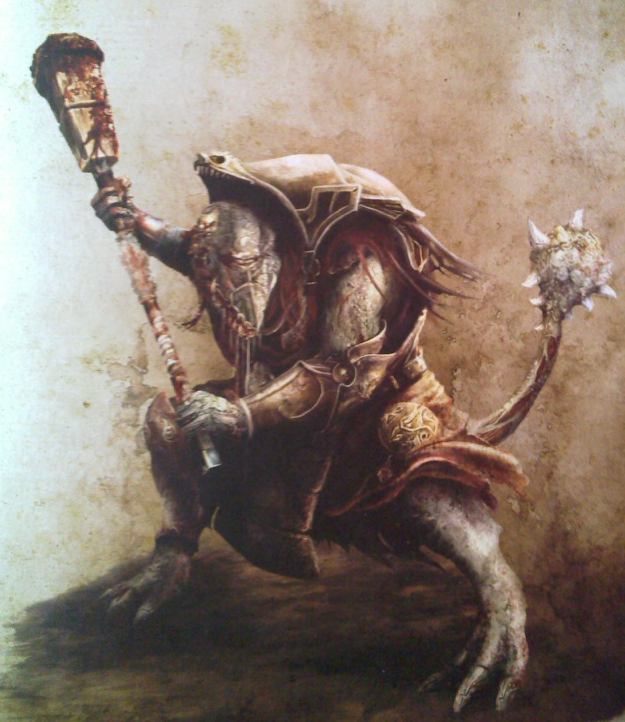


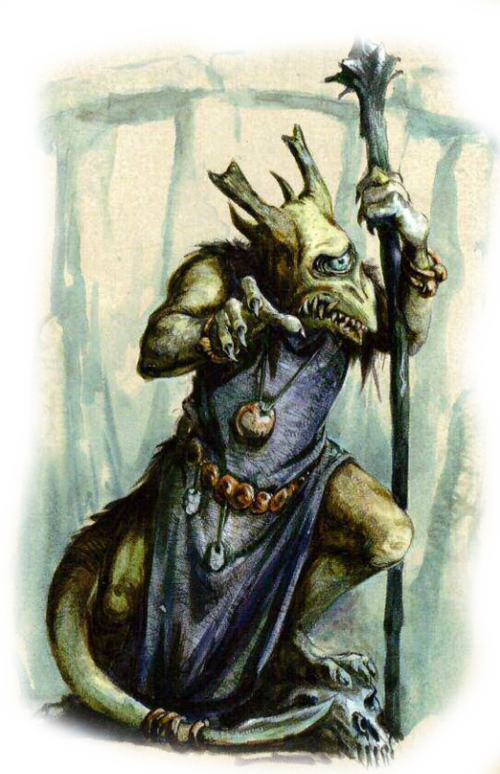
Lore of Spirits
The Lore of Spirits is the magic of shamanism. Practitioners are skilled at both defeating malevolent spirits like the Ethereal Undead and invoking the aid of their tribes’ tutelary spirits through the following spells: Spirit Staff, Fire of Vengeance, Spirit's Voice, Defeat Disease Spirit, Message of Doom, Spirit Shield.
Spellcasting
Every time that you cast a spell from the Lore of Spirits you have to roll a d20 and gain half that much Spirit Points.
Results of 18, 19 or 20 represent respectively a minor, major or catastrophic miscast. This means that the spell fails in the way explained in its description and the DM has to roll on the appropriate Chaos Manifestation Table for ulterior effects.
You have a pool of maximum 50 Spirit Points, when you gain more than this amount you become unstable and you might loose control over the spirit world. Every round of combat that you end with more than 50 Spirit Points you have to succeed on a Charisma saving throw (DC = currents Spirit Points-50) or suffer 8d10 psychic damage as 1d6 angry ghosts rips through your mind and materialise around you attacking everyone nearby.
Spirits Quietening: As an action you can concentrate on calming down the spirit world, loosing 1d12 + Cha modifier Spirit Points. Otherwise you automatically calm it down when not casting any Lore of Spirits spell at a rate of 1 Spirit Point lost every round.
Spirit Staff
Spiritual transmutation
- Casting Time: 1 action
- Range: touch
- Components: V, S
- Duration: Concentration, up to 1 hour
Your weapon, which must be a quarterstaff, is imbued with the souls of your tribes’ spirits, that guide your strikes and empower them with the strength of your ancestors. For the duration it becomes a magic quarterstaff +2 and it deals 2d8 additional force damage.
Miscast: On a 18-19 the spell is interrupted with no effects, on a 20 you lose control of your magic causing your staff to explode dealing 2d10 force damage in a 3m radius around you.
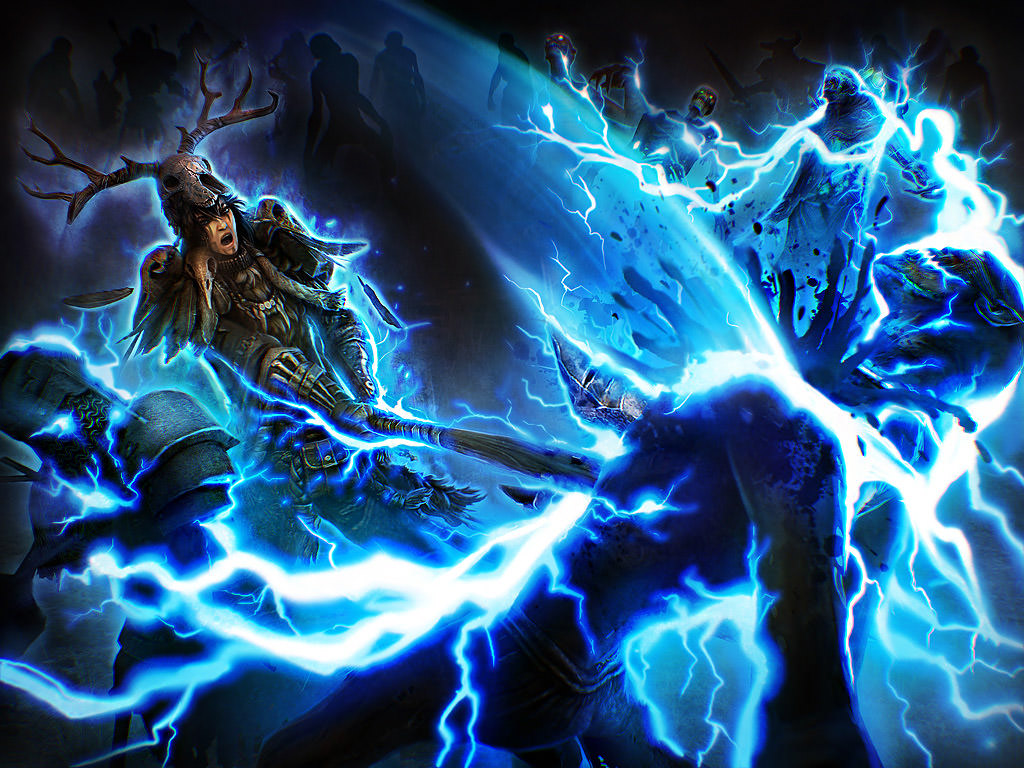


Defeat Disease Spirit
Spiritual abjuration
- Casting Time: 1 action
- Range: Touch
- Components: V, S
- Duration: Instantaneous
You can tap into the soul of one creature with your touch, trying to rid it from a malevolent presence restoring it to an healthy state. You can reduce the target's exhaustion level by one, or end one of the following effects on the target:
- One effect that charmed or petrified the target
- One curse, including the target's attunement to a cursed magic item
- Any reduction to one of the target's ability scores
- One effect reducing the target's hit point maximum
Miscast: On a 18-19 the spell is interrupted with no effects, on a 20 your spiritual intrusion damages the target's soul that suffers 6d10 psychic damage.
Spirit Shield
Spiritual abjuration
- Casting Time: 1 action
- Range: 20m
- Components: V
- Duration: Concentration up to 1 hour
The spirits watch over your tribe and protect it from harm. Ghostly figures appear and surround any number of creatures of your choice within range, granting them a +2 bonus to AC and advantage on Strength and Dexterity saving throws for the duration.
Miscast: On a 18-19 the spell is interrupted with no effects, on a 20 the spirits are harmful and distract the targets causing a -2 penalty to AC and disadvantage on Strength and Dexterity saving throws for 1 minute.
Message of Doom
Spiritual illusion
- Casting Time: 1 action
- Range: 40m
- Components: V, S
- Duration: 1 minute.
You appear in the dreams of a creature you know and foretell his doom at your hands. You needn’t speak the same language, as the dream vividly shows the target in his own gruesome death. The spell takes effect the next time the target sees you, he must make a Wisdom saving throw. On a failed save, the target becomes frightened for the duration. At the start of each of the target's turns before the spell ends, the target must succeed on a Wisdom saving throw or take 4d10 psychic damage. On a successful save, the spell ends.
Miscast: On a 18-19 the spell is interrupted with no effects, on a 20 the target is aware of your illusions and becomes enraged at you for your mind intrusion. It has permanently advantage on saving throws against your spells and on attack rolls against you.
Spirit's Voice
Spiritual divination
- Casting Time: 1 minute
- Range: self
- Components: V, S, M (the bones of a powerful ancestor)
- Duration: 8 hours
With the help of the spirits you gain a limited ability to see into the near future, as voices fill your head alerting of immediate danger. For the duration you can't be surprised and have advantage on attack rolls, ability checks, and saving throws. Additionally, other creatures have disadvantage on attack rolls against you for the duration. This spell immediately ends if you cast it again before its duration ends.
Miscast: On a 18-19 the spell is interrupted with no effects, on a 20 the voices are loud and out of control. For the duration you have disadvantage on attack rolls, ability checks and saving throws. Additionally, other creatures have advantage on attack rolls against you.
Fire of Vengeance
Spiritual evocation
- Casting Time: 1 action
- Range: 20m
- Components: V, S
- Duration: Concentration up to 1 minute
You can materialise your anger within range in the form of 1d4+1 fiery spirits that lasts for the duration or until you cast this spell again. When you cast the spell, you can make a melee spell attack for each spirit summoned against a creature within 1,5m of it. On a hit, the target takes fire damage equal to 2d8 + your spellcasting ability modifier. As a bonus action on your turn, you can move the spirits up to 9m and repeat the attack against a creature within 1,5m of it. The spirits are a manifestation of your greatest ancestors, eagers to join you in battle to turn your foes into ash.
Miscast: On a 18-19 the spell is interrupted with no effects, on a 20 you summon the wrong spirits that appear around you and try to attack you until you manage to banish them with a concentration check (Constitution) (DC=15), or after 1 minute.
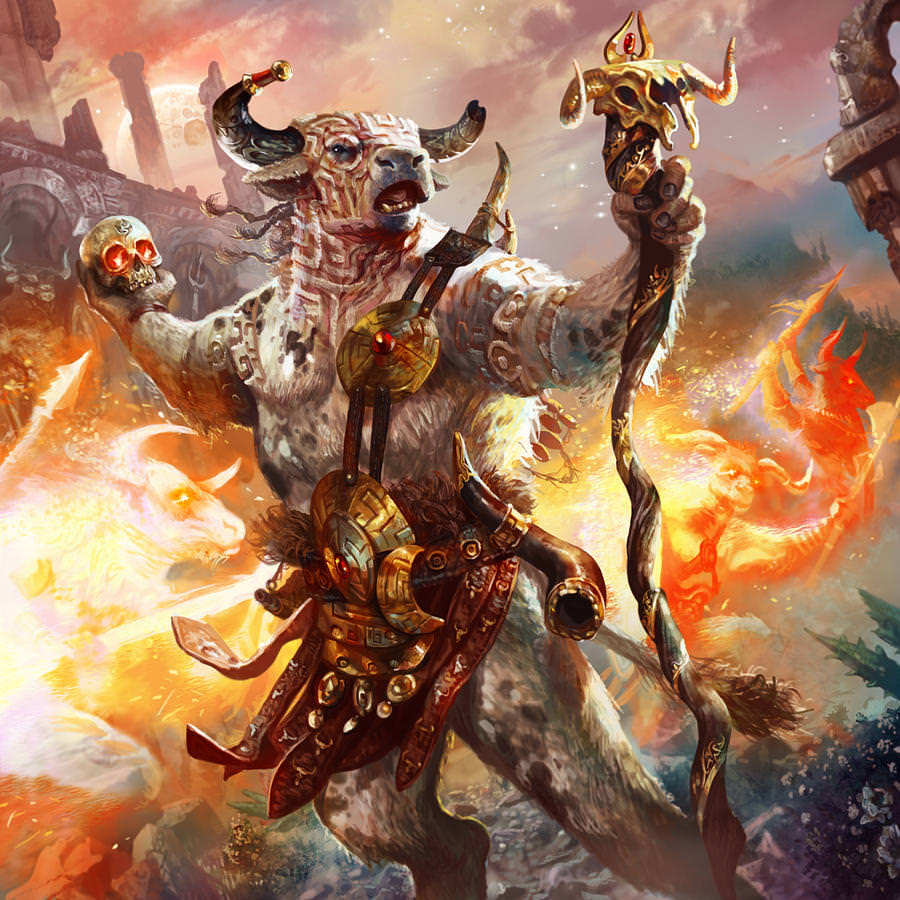


Trolls
Trolls are large humanoid monsters, as witlessly stupid as they are bone-crushingly powerful. They commonly join rampaging armies for the promise of food. Trolls are voracious creatures, mostly motivated by food and eating more than anything else, and appropriately, their digestive systems can cope with almost anything, including, as rumored, rock and metal. Trolls are infamous for several abilities. Their digestive juices are among the most corrosive acids known in the Old World, and disembowelling a Troll can often result in the death of the attacker himself as the acid sprays out. Secondly, Trolls possess an uncanny ability of quickly regenerating even the most grievous wounds. In due time almost all wounds will be healed, except if damaged with their only known weakness, fire.
Habitat. Trolls are found in their greatest numbers in the lands of Troll Country, which borders the lands of Norsca to the north and other Chaos tainted regions in close proximity to the Chaos Wastes. Trolls are by nature creatures of Chaos, the corrupting taint of Chaos playing a primary role in their origins and continued existence.
The Troll Country consists of steppe slowly turning into tundra as one travels north before meeting the great mountains and the edge of the Chaos Wastes. It is some of the least forgiving land in the Old World, and no farming is possible. There are some forests and two main ranges of hills, but for the most part, it is largely flat. It is easy to travel for days without seeing any settlements here. The weather is harsher than in most parts of Kislev, always frigid even extending through spring and autumn. Winter can blanket several feet of snow fall over most of the area, making movement impossible. Most of the creatures who live here spend the winter in one place, preparing for the troubles that come with the thaw.
Weaponry. Trolls sometimes make use of weapons, such as primitive stone clubs and bones, although they are more than capable of ripping someone apart with their bare hands and claws.
Variants. All Trolls have been affected by Chaos to some extent, as their species is the result of thousands of years of warping influence from the corrupting power of the north. However Chaos trolls have been particularly corrupted as they sport all manner of mutations, making them even more hideous than their common cousins, and the power of the Winds of Magic stokes their natural aggression and strength, turning them from mere monsters into some of the most terrible beasts in the armies of Chaos. The Troll's ability to shrug off wounds, along with its prodigious physical strength and its corrosive vomit, are all enhanced by its exposure to Chaos. Stone Trolls are a distinct breed of Troll which live exclusively in caves and mountainous regions of the world, hence their name. Since they live on rocky mountains, they tend to consume large quantities of stone and rock, the natural magical inertia of the stone imbues them with a certain degree of magical resistance.
A River Troll lives within dirty rivers, marshes and other foul waters, somewhat resembling the bottom of the river, if that riverbed is particularly coated in sediment, slime, rotting vegetation, fish carcasses, and various other smelly detritus whose precise nature and origin are too horrible to contemplate. In all probability the River Troll’s stink is even worse than that of the riverbed, since one can add the Troll’s personal miasma to the ill omened mélange of odors emitted from the mucky smears on its skin.
Ice Trolls are the breed that inhabits the frozen norscan mountains, living off mostly on ice and snow since their lands are barren and preys are scarce. They occasionally accompany the norsemen in their raids or group up into troll's warbands to plunder more fertile regions and fill up their bellies. They are particularly resistants to cold climates and their physical appearance resembles that of their common cousins if they were left for decades freezing in the chillest temperatures.
Chaos Troll
Large giant, chaotic evil
- Armor Class 16 (natural armor)
- Hit Points 115 (10d10 + 60)
- Speed 9m.
STR DEX CON INT WIS CHA 23(+6) 10(+0) 22(+6) 5(-3) 10(+0) 7(-2)
- Saving Throws Str +9, Con +9
- Skills Athletics +9, Perception +3
- Senses darkvision, passive Perception 13
- Languages Giant
- Challenge 8 (3900 XP)
Keen Smell. The troll has advantage on Wisdom (Perception) checks that rely on smell.
Greater Regeneration. The troll regains 20 hit points at the start of its turn. If the troll takes fire damage, this trait doesn't function at the start of the troll's next turn. The troll dies only if it starts its turn with 0 hit points and doesn't regenerate.
Greater Acid Explosion. When the troll dies it explodes bursting acid everywhere in a 3m radius. Each creature in the area of effect must take a Dexterity saving throw (DC=16). A creature takes 10d6 acid damage on a failed save or half as much damage on a successful one.
Mutant Type. The troll has one of the following mutations:
- Two Heads. A troll with an extra head has advantage on Wisdom (Perception) checks and on saving throws against being blinded, charmed, deafened, frightened and stunned.
- Extra Arm. A troll with an extra arm can carry three objects simultaneously and can make one additional claws attack as part of its attack action.
- Giant Tentacle. A troll with a giant tentacle has advantage on grapple checks and on attack rolls against creatures it is grappling.
Actions
Multiattack. The troll makes four attacks: one with its bite and three with its claws or club.
Bite. Melee Weapon Attack: +9 to hit, reach 1,5m, one target. Hit: 9 (1d6 + 6) piercing damage.
Claws. Melee Weapon Attack: +9 to hit, reach 1,5m, one target. Hit: 13 (2d6 + 6) slashing damage.
Club. Melee Weapon Attack: +9 to hit, reach 1,5m, one target. Hit: 15 (2d8 + 6) bludgeoning damage.
Vomit (Recharge 5-6). The troll vomits a stream of acid in a 4,5m cone. Each creature in that area must make a DC 16 Dexterity saving throw, taking 27 (6d8) acid damage on a failed save, or half as much damage on a successful one.
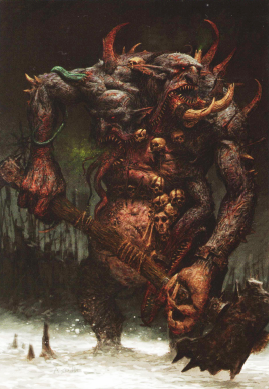


Stone Troll
Large giant, chaotic evil
- Armor Class 18 (natural armor)
- Hit Points 105 (10d10 + 50)
- Speed 9m, burrow 6m.
STR DEX CON INT WIS CHA 20(+5) 8(-1) 21(+5) 5(-3) 10(+0) 7(-2)
- Saving Throws Str +8, Con +8
- Skills Athletics +8, Perception +3
- Damage Resistances piercing, slashing from nonmagical weapons
- Senses darkvision, passive Perception 13
- Languages Giant
- Challenge 7 (2900 XP)
Keen Smell. The troll has advantage on Wisdom (Perception) checks that rely on smell.
Regeneration. The troll regains 10 hit points at the start of its turn. If the troll takes fire damage, this trait doesn't function at the start of the troll's next turn. The troll dies only if it starts its turn with 0 hit points and doesn't regenerate.
Acid Explosion. When the troll dies it explodes bursting acid everywhere in a 3m radius. Each creature in the area of effect must take a Dexterity saving throw (DC=15). A creature takes 6d6 acid damage on a failed save or half as much damage on a successful one.
Stone Camouflage. The troll has advantage on Dexterity (Stealth) checks made to hide in rocky terrain.
Stony Skin. The troll has advantage on saving throws against spells and spell-like effects.
Actions
Multiattack. The troll makes three attacks: one with its headbutt and two with its claws or club.
Headbutt. Melee Weapon Attack: +8 to hit, reach 1,5m, one target. Hit: 10 (1d10 + 5) bludgeoning damage.
Claws. Melee Weapon Attack: +8 to hit, reach 1,5m, one target. Hit: 12 (2d6 + 5) slashing damage.
Club. Melee Weapon Attack: +8 to hit, reach 1,5m, one target. Hit: 14 (2d8 + 5) bludgeoning damage.
Vomit (Recharge 5-6). The troll vomits a stream of acid in a 4,5m cone. Each creature in that area must make a DC 15 Dexterity saving throw, taking 21 (6d6) acid damage on a failed save, or half as much damage on a successful one.
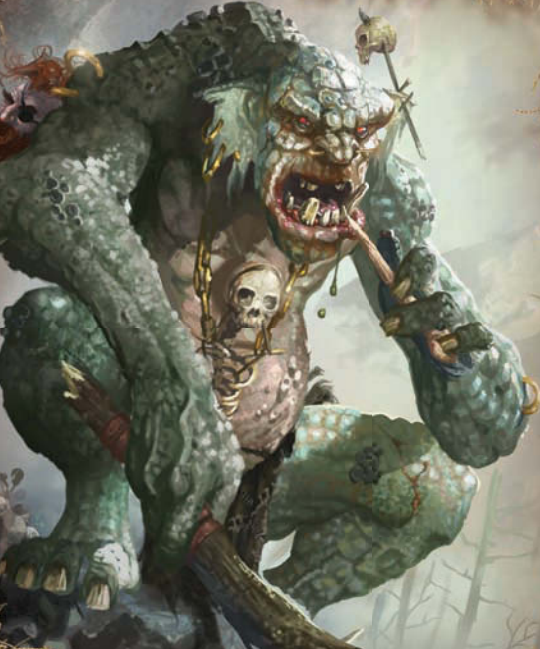


Common Troll
The most common, average troll has the stats of a Troll (page 291 Monster's Manual) with the following changes:
- it has the Vomit (Recharge 5-6) attack option. The troll vomits a stream of acid in a 4,5m cone. Each creature in that area must make a DC 15 Dexterity saving throw, taking 21 (6d6) acid damage on a failed save, or half as much damage on a successful one.
- it has the Acid Explosion feature. When the troll dies it explodes bursting acid everywhere in a 3m radius. Each creature in the area of effect must take a Dexterity saving throw (DC=15). A creature takes 6d6 acid damage on a failed save or half as much damage on a successful one.
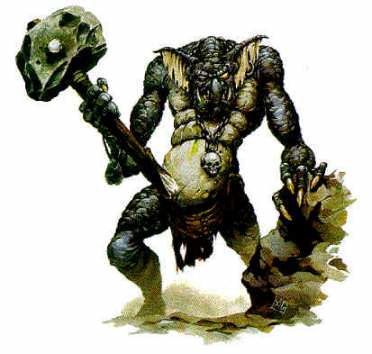
Petra Langenmesser, Village Fishwife:
"Them River Trolls is the worst. If they ever move into a lake or river you’re fishing, there’s no getting them out again, leastways not without my help. They pull folks out of their boats and down to their dooms. Worse than that, they eat all the fish. One of them comes to my lake, but I fixed him good and proper. It weren’t easy. First I cursed him. That weakened him a bit. Then I got the whole village together and we cleaned up the lake dragged it for bodies and junk, stopped people using it to throw rubbish in, even picked out the bits of weed and twig from the surface. After a few weeks of that he moved downriver to the smellier lake by the next village. If that hadn’t have worked I’d have had to stick my knife in him. Everyone’s scared of my knife, even Trolls."
River Troll
Large giant, chaotic evil
- Armor Class 15 (natural armor)
- Hit Points 84 (8d10 + 40)
- Speed 9m, swim 12m.
STR DEX CON INT WIS CHA 19(+4) 13(+1) 20(+5) 6(-2) 12(+1) 7(-2)
- Saving Throws Str +7, Con +8
- Skills Athletics +7, Perception +4
- Damage Resistances acid, poison
- Senses darkvision, passive Perception 14
- Languages Giant
- Challenge 7 (2900 XP)
Amphibious. The troll can breathe air and water.
Keen Smell. The troll has advantage on Wisdom (Perception) checks that rely on smell.
Regeneration. The troll regains 10 hit points at the start of its turn. If the troll takes fire damage, this trait doesn't function at the start of the troll's next turn. The troll dies only if it starts its turn with 0 hit points and doesn't regenerate.
Swamp Camouflage. The troll has advantage on Dexterity (Stealth) checks made to hide in swampy terrain.
Acid Explosion. When the troll dies it explodes bursting acid everywhere in a 3m radius. Each creature in the area of effect must take a Dexterity saving throw (DC=15). A creature takes 6d6 acid damage on a failed save or half as much damage on a successful one.
Surprise Attack. If the troll surprises a creature and hits it with an attack during the first round of combat, the target takes an extra 10 (3d6) damage from the attack.
Actions
Multiattack. The troll makes three attacks: one with its bite and two with its claws or club.
Bite. Melee Weapon Attack: +7 to hit, reach 1,5m, one target. Hit: 7 (1d6 + 4) piercing damage plus 5 (1d10) acid damage.
Claws. Melee Weapon Attack: +7 to hit, reach 1,5m, one target. Hit: 11 (2d6 + 4) slashing damage plus 4 (1d8) acid damage.
Club. Melee Weapon Attack: +7 to hit, reach 1,5m, one target. Hit: 13 (2d8 + 4) bludgeoning damage.
Vomit (Recharge 4-6). The troll vomits a stream of acid in a 4,5m cone. Each creature in that area must make a DC 15 Dexterity saving throw, taking 21 (6d6) acid damage on a failed save, or half as much damage on a successful one.
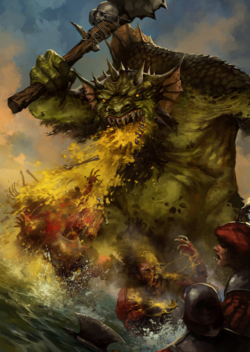


Ice Troll
Large giant, chaotic evil
- Armor Class 16 (natural armor)
- Hit Points 84 (8d10 + 40)
- Speed 9m.
STR DEX CON INT WIS CHA 20(+5) 15(+2) 21(+5) 5(-3) 14(+2) 7(-2)
- Saving Throws Str +8, Con +8
- Skills Athletics +8, Perception +5
- Damage Immunities cold
- Damage Vulnerabilities fire
- Senses darkvision, passive Perception 15
- Languages Giant
- Challenge 7 (2900 XP)
Chill Aura. A creature that touches the troll or hits it with a melee attack in a 1,5m range takes 7 (2d6) cold damage.
Keen Smell. The troll has advantage on Wisdom (Perception) checks that rely on smell.
Regeneration. The troll regains 10 hit points at the start of its turn. If the troll takes fire damage, this trait doesn't function at the start of the troll's next turn. The troll dies only if it starts its turn with 0 hit points and doesn't regenerate.
Acid Explosion. When the troll dies it explodes bursting acid everywhere in a 3m radius. Each creature in the area of effect must take a Dexterity saving throw (DC=15). A creature takes 6d6 acid damage on a failed save or half as much damage on a successful one.
Snow Camouflage. The troll has advantage on Dexterity (Stealth) checks made to hide in snowy terrain.
Actions
Multiattack. The troll makes three attacks: one with its bite and two with its claws or ice club.
Bite. Melee Weapon Attack: +8 to hit, reach 1,5m, one target. Hit: 8 (1d6 + 5) piercing damage plus 4 (1d8) cold damage.
Claws. Melee Weapon Attack: +8 to hit, reach 1,5m, one target. Hit: 12 (2d6 + 5) slashing damage.
Ice Club. Melee Weapon Attack: +8 to hit, reach 1,5m, one target. Hit: 14 (2d8 + 5) bludgeoning damage plus 9 (2d8) cold damage.
Vomit (Recharge 5-6). The troll vomits a stream of acid in a 4,5m cone. Each creature in that area must make a DC 15 Dexterity saving throw, taking 21 (6d6) acid damage on a failed save, or half as much damage on a successful one.
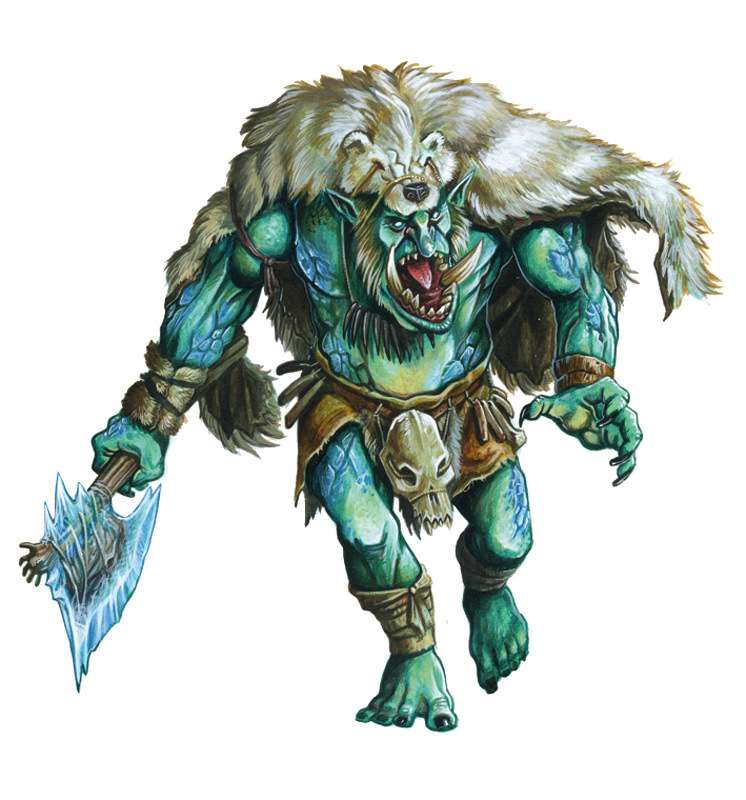
Throgg, King of the Trolls
Throgg is among the most unnaturally intelligent of his vile kind, intent on bringing the world under the rule of a new ice age with himself at its head. Even the most lackwit child knows that Trolls are grossly stupid beasts. Nonetheless, around the campfires of the north, there persist rumors that in the depths of Troll Country there is an elder beast whose mutations were not just of the body but also the mind, a Troll King possessed of a grim and malevolent cunning who seeks to grind the realms of Man under his monstrous rule.
At the heart of an icy labyrinth strewn with the gnawed corpses of once mighty heroes, the Troll King, Throgg, sits brooding upon his rocky throne. No fanfare announces his arrival, no vassals pay him tithe, and no courtiers vie for his favor. His subjects are drooling, stinking monsters and his domain is a desolate and wind whipped wasteland. A filth encrusted crown rings one of the Troll King’s tusks, a once priceless heirloom taken from a great warrior whose quest led him only into Throgg’s gullet
There was a time when Throgg was content purely with a life of hunting, raiding and killing. He led his monstrous kin in ambushes and midnight attacks, each more successful than the last. Throgg had a knack of using the harsh climate of the north as his ally, for Trolls are quite at home in the numbing cold; to them a fierce ice shard blizzard is no more troubling than a light summer rain. Before long, the Troll King became infamous, known amongst the warriors of the Old World as Wintertooth. Every season, great and lauded heroes would ride northwards, brave knights and adventurers, all seeking out Throgg’s lair to slay him. Every season, the Troll King dined upon noble flesh.
One moonless night, as Throgg was picking his yellowed tusks clean with a gem encrusted blade, he beheld the broken bodies of his prey and began to think. Throgg muttered to himself, his eyes burning with cold fire for several long days. If the race of Man was so keen to fight him and his bestial subjects, then fight he would, with all the monsters of Troll Country at his side. That night, Throgg vowed that he would see the lands of Men despoiled in the name of the Dark Gods. He would gather every monster, mutant and madman under his rule and march at the head of a nightmarish horde deep into the so called civilised lands of the south. On his heels would come the bitter cold of winter, for where the creatures of Chaos tread, the land itself warps and changes. Throgg would bring about an age of ice and darkness and make all of the races of the Old World his slaves. As the Troll King marches determinedly south, his monstrous entourage grows with every passing day. Under Throgg’s dominion, the creatures of the hinterlands have united into a vast army, and soon the race of Man shall feel the Troll King’s wrath.
Throgg Wintertooth
Large giant, chaotic evil
- Armor Class 19 (natural armor)
- Hit Points 297 (22d10 + 176)
- Speed 9m.
STR DEX CON INT WIS CHA 24(+7) 10(+0) 27(+8) 20(+5) 16(+3) 18(+4)
- Saving Throws Str +12, Con +13, Int +10
- Skills Athletics +12, Deception +9, Perception +8, Persuasion +9
- Damage Immunities cold, poison
- Condition Immunities frozen, poisoned
- Senses darkvision, passive Perception 18
- Languages Common, Giant
- Challenge 18 (20000 XP)
Legendary Resistance (3/day). If Throgg fails a saving throw, he can choose to succeed instead.
Keen Smell. Throgg has advantage on Wisdom (Perception) checks that rely on smell.
Greater Regeneration. Throgg regains 20 hit points at the start of his turn. If he takes fire damage, this trait doesn't function at the start of his next turn. Throgg dies only if he starts his turn with 0 hit points and doesn't regenerate.
Greater Acid Explosion. When Throgg dies, he explodes bursting acid everywhere in a 6m radius. Each creature in the area of effect must take a Dexterity saving throw (DC=18). A creature takes 10d10 acid damage on a failed save or half as much damage on a successful one.
The Wintertooth Crown. This magic item grants its carrier a +4 bonus to Intelligence and Charisma and advantage on saving throws against mind-affecting spells.
Actions
Multiattack. Throgg can use his Roar. He then makes four attacks: one with his bite and three with his claws or frost maul.
Bite. Melee Weapon Attack: +12 to hit, reach 1,5m, one target. Hit: 16 (2d8 + 7) piercing damage.
Claws. Melee Weapon Attack: +12 to hit, reach 1,5m, one target. Hit: 21 (4d6 + 7) slashing damage.
Frost Maul +2. Melee Weapon Attack: +14 to hit, reach 1,5m, one target. Hit: 19 (3d6 + 9) bludgeoning damage plus 11 (2d10) cold damage. On a natural 20, on the attack roll, the target must succeed in a Constitution saving throw (DC=15) or be frozen in place. Each round while frozen the creature suffers 6d10 cold damage. It can attempt, at the end of its turn, to break free from the ice with a successful Strength (Athletics) check (DC=20).
Roar. Throgg can emit a mighty roar that is audible from kms away and that draws his monstrous subjects to his aid. In addition each creature in a 9m radius around Throgg must make a Constitution saving throw (DC=18). A creature is deafened for 1 minute and suffers 18 (4d8) thunder damage on a failed save, or half as much damage on a successful one.
Vomit (Recharge 5-6). Throgg vomits a stream of acid in a 9m cone. Each creature in that area must make a DC 18 Dexterity saving throw, taking 42 (10d8) acid damage on a failed save, or half as much damage on a successful one.
Legendary Actions
Throgg can take 3 legendary actions, choosing from the options below. Only one legendary action option can be used at a time and only at the end of another creature's turn. Throgg regains spent legendary actions at the start of his turn.
Claws. Throgg makes a claws attack.
Moves. Throgg can move up to his speed.
Bonebreaker (Costs 2 Actions). Throgg can attempt a Strength (Athletics) check to grapple a large or smaller creature. If he is successful the creature must make a Constitution saving throw. The creature is paralyzed and suffers 22 (4d10) bludgeoning damage on a failed save, or half as much damage on a successful one. The creature can try to wear off its paralysis re-attempting the saving throw at the end of each of its turn.
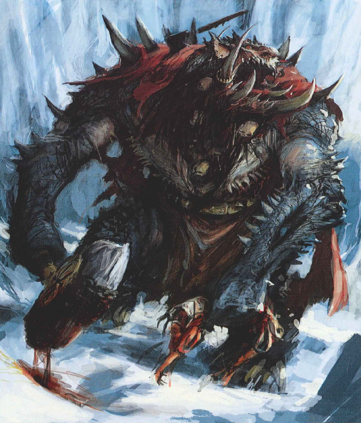


Chaos War Mammoths
Chaos War Mammoths are a tainted and savage race of Mammoths that have been transformed by the raw and mutating powers of Chaos into beasts of destruction. These massive creatures, whose footfalls shake the earth like thunder, are capable through sheer bulk and roused fury of demolishing buildings, trampling forests flat and crushing anything smaller than themselves into an unrecognisable, bloody smear. Although not actually evil as such, they are entirely belligerent and uncaring beasts that cut a swathe of destruction wherever they go, a factor magnified a thousand-fold by the fact that when they have young they travel in communal family herds, are fiercely territorial and respond to any other creature that manages to gather their notice by smashing it into the ground, or if it is a large enough monster in its own right, impaling it with huge tusks the size of mighty tree trunks
To the Chaos touched tribes of the Northern Wastes, the Mammoths are living totems of might and power, beasts who go where they will and destroy what they will, and are so considered sacred creatures in their own right, that to tribes which through fortune, sorcery, or the favor of the gods come to bring one of these creatures into the fold (for none can ever be truly tamed), great honor and fear is attached. The Mammoths roam all across the north, feeding off blasted scrubland and thorny barrens and, from the shores of the Sea of Claws to the cold wastes of K'dathi they are venerated by Norscans and Hung alike; but it is the Dolgan tribes that have historically had the most success adding the prodigious strength of the Chaos Mammoths to that of their tribes through the jealously guarded secrets of their shaman. These Chaos War Mammoths, or vraszas is the name given to them by the Dolgan, make fearsome foes in battle against which few mortals have a hope of standing firm against. The greatest warriors of the tribe ride into battle on their backs, fighting from fortified wooden platforms while others, given over to the tribe's shaman sorcerers, carry the mighty war altars of the Chaos Gods, held aloft and inviolable for all below to see.
War Mammoth
Gargantuan beast, unaligned
- Armor Class 13 (natural armor)
- Hit Points 217 (14d20 + 70)
- Speed 15m.
STR DEX CON INT WIS CHA 25(+7) 9(-1) 21(+5) 3(-4) 11(+0) 6(-2)
- Damage Resistances bludgeoning, cold
- Senses passive Perception 10
- Languages none
- Challenge 8 (3900 XP)
Stomping Charge. If the mammoth moves at least 12m straight toward a creature and then hits it with a gore attack on the same turn , that target takes extra 18 (4d8) bludgeoning damage and must succeed on a DC 18 Strength saving throw or be knocked prone. If the target is prone, the mammoth can make one stomp attack against it as a bonus action.
Grappling Trunk. The mammoth has advantage on Strength (Athletics) checks made to grapple with its trunk.
Actions
Multiattack. The mammoth can use its trunk and then it makes a gore attack.
Gore. Melee Weapon Attack: +10 to hit, reach 3m, one target. Hit: 21 (4d8 + 7) bludgeoning damage.
Stomp. Melee Weapon Attack:+ 10 to hit, reach 1,5m, one prone creature. Hit: 25 (4d10 + 7) bludgeoning damage.
Trunk. The mammoth makes a Grappling (Strength) check against a large, or smaller, creature within 4,5m of it. If it is successful it can throw the target 1d20m away causing that much fall damage, or it can squeeze the creature causing 16 (2d8 +7) bludgeoning damage.
War-Shrine variant:
Northern warriors can go into battle riding these giant beasts upon wooden fortresses.
The war-shrine mammoth is a CR 10 (5900 XP), plus the CR of its riders, creature with the stats of a war mammoth but with the following changes:
- Its AC is 16 (iron armor)
- It has up to 6 marauders on his back that grant:
Bow attacks (1/each, +4 to hit, range
30/120m, 6 (1d8 +2) piercing damage);
two Ballista attacks (+6 to hit, range 60/300m, 16 (3d10) piercing damage).
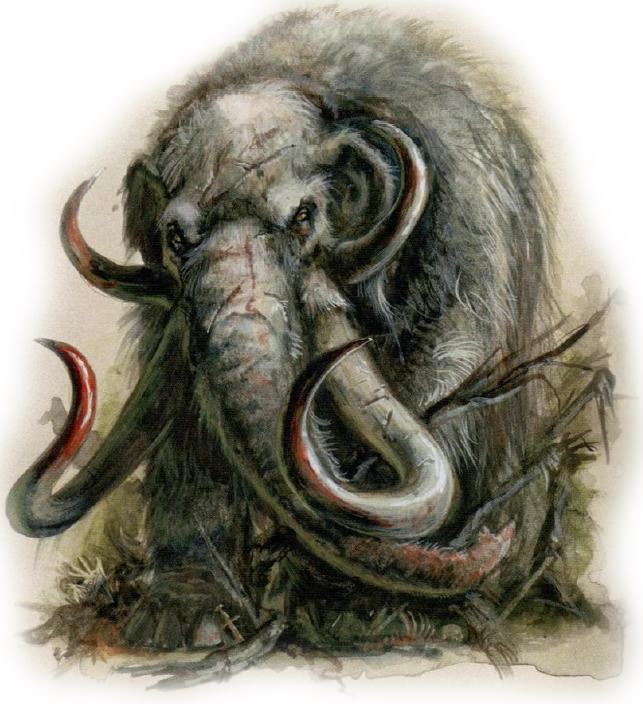
Frost Wyrms
Frost Dragons are creatures of frost and ice, the chill of midwinter given vengeful and scaly form. They are slow to anger, presumably a result of their own chill nature being combined with cold blooded physiology. Dragons seem to be a highly malleable race, adapting to their surroundings with time. The Dragons of the northern regions have changed so far from their origins that their breath has lost its fire, instead becoming a cold mass of icy vapor that can freeze their foes in instants. Those that have changed the most are, of course, those that have fallen to Chaos. The mutating power of Chaos has touched more than just trolls and wolves in the malign wilderness of Troll Country. In its northern reaches, just below the surface of the frozen tundra, Frost Wyrms lurk in their underground lairs. With the appearance of giant, winged monsters, nobody is entirely sure of their true nature or origins, but they are certainly abominable creatures tainted by Chaos. Some say that before the species mutated, they may have been Ice Dragons, a creature with a similarly dangerous killing ability in its icy, freezing breath, and a gargantuan size proportional to its age. Lying motionless beneath the frozen tundra, the cold-blooded Frost Wyrm waits for the footfalls of trespassers before emerging to freeze them to death in their tracks.
Ancient Frost Dragon
Gargantuan dragon, chaotic evil
- Armor Class 20 (natural armor)
- Hit Points 333 (18d20 + 144)
- Speed 12m, burrow 12m, fly 24m, swim 12m.
STR DEX CON INT WIS CHA 26(+8) 10(+0) 26(+8) 12(+1) 13(+1) 14(+2)
- Saving Throws Dex +6, Con +14, Wis +7, Cha +8
- Skills Perception +13, Stealth +6
- Damage Immunities cold
- Senses blindsight, darkvision, passive Perception 23
- Languages Common, Draconic
- Challenge 21 (33000 XP)
Legendary Resistance (3/Day). If the dragon fails a saving throw, it can choose to succeed instead.
Ice Walk. The dragon can move across and climb icy surfaces without needing to make an ability check. Additionally, difficult terrain composed of ice or snow doesn't cost it extra moment.
Mutation. As a descendant of Galrauch the Frost Wyrm possesses an extra head that grants advantage on Wisdom (Perception) checks and on saving throws against being blinded, charmed, deafened, frightened and stunned.
Actions
Multiattack. The dragon can use its Frightful Presence. It then makes four attacks: two with its bite and two with its claws.
Bite. Melee Weapon Attack:+ 14 to hit, reach 4,5m, one target. Hit: 19 (2d10 + 8) piercing damage plus 9 (2d8) cold damage.
Claw. Melee Weapon Attack: +14 to hit, reach 3m, one target. Hit: 15 (2d6 + 8) slashing damage.
Tail. Melee Weapon Attack: +14 to hit, reach 6m, one target. Hit: 17 (2d8 + 8) bludgeoning damage.
Frightful Presence. Each creature of the dragon's choice that is within 36m of the dragon and aware of it must succeed on a DC 16 Wisdom saving throw or become frightened for 1 minute. A creature can repeat the saving throw at the end of each of its turns, ending the effect on itself on a success. If a creature's saving throw is successful or the effect ends for it, the creature is immune to the dragon's Frightful Presence for the next 24 hours.
Cold Breath (Recharge 5-6, roll separately for each head). Each one of the dragon's head can exhales an icy blast in a 27m cone. Each creature in that area must make a DC 22 Constitution saving throw, taking 45 (10d8) cold damage on a failed save, or half as much damage on a successful one.
Legendary Actions
The dragon can take 3 legendary actions, choosing from the options below. Only one legendary action option can be used at a time and only at the end of another creature's turn. The dragon regains spent legendary actions at the start of its turn.
Detect. The dragon makes a Wisdom (Perception) check.
Tail Attack. The dragon makes a tail attack.
Wing Attack (Costs 2 Actions). The dragon beats its wings. Each creature within 4,5m of the dragon must succeed on a DC 22 Dexterity saving throw or take 15 (2d6 + 8) bludgeoning damage and be knocked prone. The dragon can then fly up to half its flying speed.
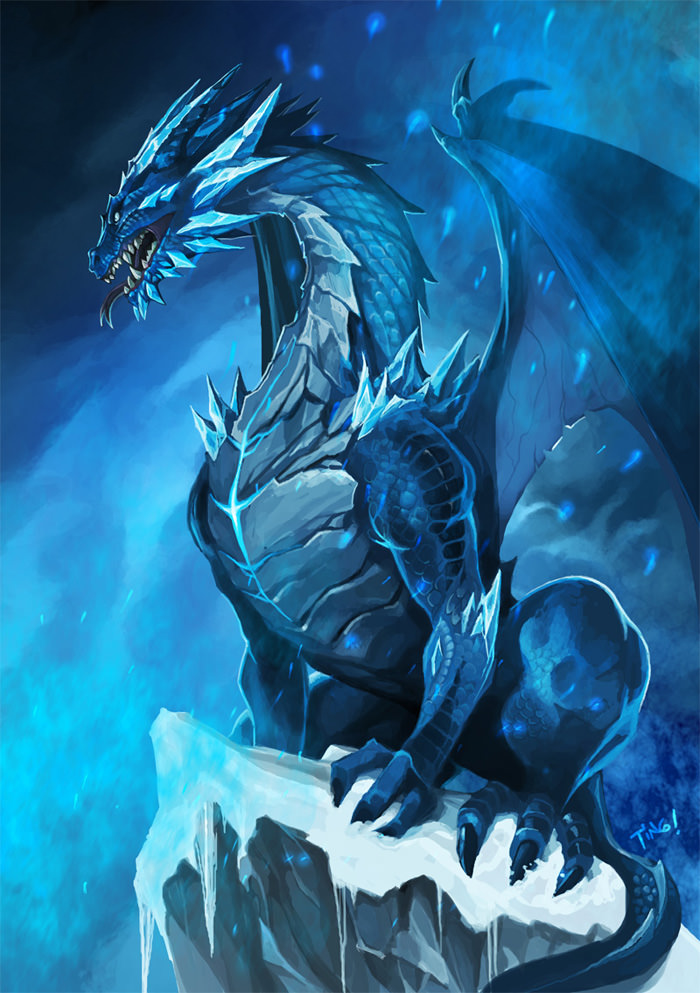


Wulfrik the Wanderer
Wulfrik the Wanderer, known also as the Eternal Challenger, the Inescapable One and the World Walker, is the ultimate seafaring warrior. A mighty giant of a man, clad in hulking plate and bedecked in the trophies of his many kills, Wulfrik travels the four corners of the world, seeking the greatest and most deadly warriors and beasts to bring them to battle and slaughter them as demanded by the Gods.
One of the most devoted followers of Chaos to walk the earth, Wulfrik has made offerings of lords, kings, sea serpents and dragons to his masters. To Khorne he offers up their skulls, to Nurgle the contents of their slit bellies, to Slaanesh their still beating hearts, and to Tzeentch their dying breath.
History. In his former life, Wulfrik was a Chaos Champion of the Sarl tribe of southern Norsca. A natural born killer who bore the Mark of the Dark Gods upon his flesh; he was ever renowned throughout the holdings of his tribe and beyond as a superlative warrior, feared for his prodigious strength and unmatched skill at arms. Wulfrik forged his infamy by taking the heads of every rival Chaos Champion who crossed his path, proudly displaying them for all to see as a declaration of his power and the folly of challenging him. In the violent societies of Norsca, Wulfrik was famed, and many sagas were sung to his glory by the skald chanters of the Sarls. Pride proved the Chosen's downfall, however.
It was 2519 IC that a massive bout of tribal conflict had erupted between the Sarls and their traditional rivals, the Aeslings of the north. The Aeslings were led by their king, a terrible Chaos Lord known as Torgald. Outnumbered and outmatched, it seemed doom had come for the men of the Sarls, with only bloody death awaiting them at the hands of their merciless cousins.
However, the Sarls themselves were not entirely without means. Their king, a Chosen of Tzeentch known as Viglundr was a cunning warlord, who possessed great wealth as a result of many profitable raids, and thus was able to procure the services of legions of mercenaries from across the length and breadth of the Norscan realms and even as far abroad as the Kurgan tribes.
Recognizing Wulfrik's skill at arms, Viglundr also offered the champion untold wealth and the hand of his daughter, and thus, the status of king by inheritance if he would gain victory for the tribe. Wulfrik, though looking down upon Viglundr as a pathetic shadow of his predecessors, nonetheless grasped at the chance for power and led the hosts of the Sarls to war. Unbeknownst to Wulfrik, Sarl, or Aesling at the time, the entire war was nothing more than a highly complex, Machiavellian scheme enacted by Viglundr to eliminate Torgald, thus allowing his more pliable son, Sveinbjorn, to take the throne of the Aeslings. This would have then engendered an alliance with the northern tribe that would see Viglundr's power, and that of the Sarls, increased by the aid of the bloodthirsty Khornate Aeslings. Indeed, the Raven God had marked the Sarl King well.
At the now legendary Battle of Thousand Skulls, the Sarls and Aeslings clashed. Amidst the carnage, Wulfrik fought the mighty Aesling King. Wulfrik slew the Chaos Lord, decapitating him and holding his head high for his tribesmen to see. With the death of their king, the Aeslings quit the field and victory was in the hands of the Sarls.
That night, as was the custom of the Northern tribes, a great feast was held in Wulfrik's honor. No man or beast, Wulfrik proclaimed, had fought more fiercely in battle than he, and none, he swore, would outdrink him in victory. Using the skull of King Torgald as his drinking vessel, Wulfrik had matched words with deeds. It had taken 8 entire barrels of mead to put him under the table, a feat that had impressed even the Ogres who fought alongside him. Before the mead completely overwhelmed him however, the drunken Wulfrik began to boast of his exploits. Before he was done, he had slain every beast of the Chaos Wastes twice and personally boxed the ears of the Emperors of the Empire, Nippon and Cathay. However, it was the champion's final boast that brought the doom upon his head. He claimed he was the equal of any warrior of the realms of the mortal world or in the realms beyond flesh.
The Curse. That night, Wulfrik was visited by an emissary of the Dark Gods. In his dreams, the daemon led him to paradises, necropolises and fantastic netherworlds. He saw the gleaming towers of the Elf folk, the gilded halls of Dwarf Lords and the ramshackle fortresses of Orcish kings. And everywhere he passed was drowned in great tides of blood. The emissary spoke of how Wulfrik's brazen words had offended his gods, but had also intrigued them enough to challenge their champion to prove his proud words. He was now charged to travel the four corners of the worlds, and to seek out the fiercest warriors, the most monstrous creatures, and most ferocious adversaries and slay them in single combat to prove his might.
If he failed, the emissary explained, then his soul would be forever cursed by the gods, and deemed unworthy to join them in their halls. He then spoke with relish of how daemons would take great pleasure in torturing his soul for all eternity should that come to pass. When Wulfrik awoke, he found himself speaking in a thousand languages and his tongue had been twisted in a sharp, fluted shape like that of a bird's. A shaman of the Kurgan tribes recognized this as the Gift of Tongues and enthusiastically pronounced Wulfrik as blessed. Wulfrik, a short tempered man by any standard, with little patience for others, made certain the Kurgan died slowly. Even as he began burning the Kurgan's toes from his feet, the Shaman was incapable of telling the Champion where the thoughts were coming from, nor how to make them stop.
Gift of Tongues:
"Face me if you dare, stunted whelp, or do you lack even an Elven maid's courage? I thought the Sons of Grungni were great warriors, but perhaps you are no true Dwarf. Indeed, maybe you are instead some breed of bearded goblin, though in truth, I have seen a finer beard on a Troll's back side." -Wulfrik the Wanderer to Dwarf King Thurbad Stonebeard, in perfect Khazalid.
The Gift allows him to issue an irrefutable challenge to any creature in their own language. The gift does not merely allow Wulfrik to speak any language, but allows his words to strike into a creature's very being and compel them to fight him. Combined with the well known Norscan aptitude for biting, albeit unsubtle, insults, Wulfrik is able to goad his enemies into a reckless fury where they are more likely to make fatal mistakes for him exploit.
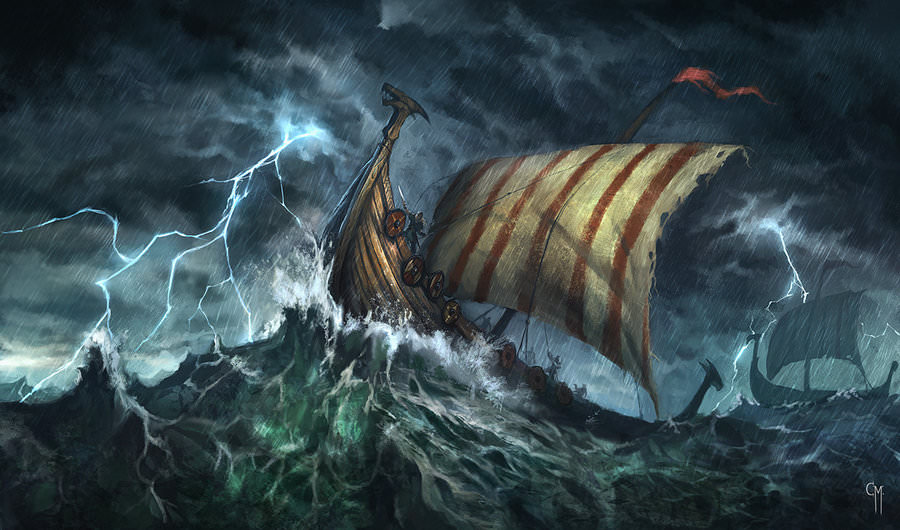



Seafang. The first test was to hunt down the Tomb Lord Khareops and offer up its shriveled entrails to Nurgle, the God of Decay. Thus, Wulfrik was charged to travel to the baking deserts of Khemri, a voyage undertaken by only the boldest of Northmen, for the desert lay many leagues south of the far north where the Norsemen made their home. In order to accomplish his new found duty, Wulfrik required transport beyond the abilities of a mere longship. In the end, it was Sigvatr, a grizzled Marauder and long time comrade, who solved the conundrum. For he had heard tales of a ship blessed by the Dark Gods with the power to circumvent the greatest distances in the blink of an eye, which was in the keeping of a Chaos Sorceress: the Skaeling witch Baga Yar, who dwelt in a vast fortress garrisoned by hordes of daemons.
It had taken all the treasure he had seized from King Torgald, as well as all the silver Viglundr had paid him in order to assemble an army large and fierce enough to overcome the unholy defenses of the Sorceress. In a battle worthy of the sagas, the Norsemen had triumphed over the daemons; proving their strength to the Dark Gods. In the end, Wulfrik hunted down the sorceress and hacked off her limbs before boiling her alive in her own cauldron. Almost 200 men had been slain facing her daemonic army, but Wulfrik and his warband had triumphed. The treasures and artefacts aside from the ship he had left to his warriors to plunder, he had come only for the witch's longship, which he then named the Seafang.
The Seafang was indeed no ordinary ship. For it was not mere flight that allowed it its legendary mobility, instead the longship would fade from the mortal world into the Realms of the gods, traveling upon the Winds of Chaos itself, past the hunting grounds of daemons and the nightmares of men, the ship would sail upon phantom tides known only to the gods and appear again where Wulfrik willed. With such power at his command, he was inescapable. Even the men of Norsca, so used to the unnatural influence of Chaos, could not help but feel awed and reverent whenever the power of the Seafang was worked. Indeed, with every invocation of the ship's magic, the daemons bound within it demanded an offering of blood before they would ferry the Norsemen through the ethereal realm of Chaos. The only offering it had the taste for was Wulfrik's own blood, perhaps because he had been the one to slay Baba Yar. Despite this, Wulfrik made certain that with each new addition to his crew he would feed the new warrior's blood to the dragon head prow. No ship could serve two captains, and this was more true of the Seafang than any other.
The Deeds. With his daemonic prize in tow, Wulfrik traveled to the land of the Tomb Kings, laying low the offering demanded of him by the gods and holding the Tomb Lord's shriveled innards high for the pleasure of Nurgle. Over time, his legend grew yet more fearsome as he stalked and slaughtered fell beings in service to the gods. It was Wulfrik who faced a giant in battle, slew it and then scalped its hairy head for a cloak. It was Wulfrik who traveled deep into the Troll Country and slaughtered the monsters there like sheep and cattle, and it was Wulfrik who journeyed to the ancient cairn of Jarl Unfir, who arose as an armored wight only to have its bony back broken over the champion's knee.
Men journeyed from all over the North to fight at the side of one so favored by the Dark Gods, in the hope that they might catch some of his greatness. Tales of a hulking champion, clad in black steel and bones wielding a dark sword had spread so far as to be spoken in awed whispers by Kurgan nomads, as well as in the bloody halls of Norscan barbarians. Thus, the fame of Wulfrik grew to gargantuan proportions, and his name lived well in the sagas of the North and the nightmares of the South.
The Plan to break the Curse. Wulfrik, cursed to an eternity of unending battle, hunted down and slew the offerings demanded of him by the Gods. He journeyed to the holds of the Dwarfen Lords and took from them both glory and gold, killed mighty dragons and even slew the unworthy champions of the gods from amongst the tribes of Kurgan and Hung. All men of the northlands honored his name and envied the favor the gods had shown him, but deep within his cold heart Wulfrik despised his curse, and despised even more those who thought it a blessing. His wish, for a time at least, was to break it and return to his own quest for power and glory.
Upon returning from one of his hunts to the Sarl city of Ormskaro, Wulfrik was approached by yet another Kurgan shaman: Zarnath of the Tokmars. The sorcerer told Wulfrik of how he could lift the Curse of the gods from him, given an ancient artefact of Chaos. In return, he asked for the Seafang. Wulfrik, despite the protests of his comrades not to trifle with the gods, agreed. For he sought to once again pursue his ambitions for lordship of the Sarls, a position he could not claim were he forever shackled to the hunt. In addition, Wulfrik had long desired to make the Sarl Princess whose hand he had been promised his woman, just as Hjordis herself lusted after the mighty champion in her own right.
Zarnath explained that in order to enact the ritual to free Wulfrik, he would require an ancient artefact of the Hung Sorcerer Kings, the Smile of Sardiss. The artefact, he said lay in one of the enclaves of the Chaos Dwarf of the Dark Lands, who sometimes had dealings with the Norsemen. With the Seafang's daemonic transportation, Wulfrik and his warriors journeyed to the foul lands of the Fire Dwarfs. There, they set out to the great fortress of Dronangkul, or 'Fortress of Iron' in the debased Khazalid of the Chaos Dwarfs, where the Kurgan claimed the Dwarfen Lord: Khorakk, and the Smile of Sardiss could be found.
Expedition into the Dark Lands. As was their way, the Norscans slaughtered their way through the defenses of the Fire Dwarfs; the blessings of Hashut proving no match for the unending fury of the Dark Gods. By any standards, the Norsemen had utterly annihilated the Dwarf Hold, an impressive feat, given their relatively small numbers. Wulfrik himself had slain a Bull Centaur Lord, as well Khorakk himself in that raid; overpowering the former in a contest of strength and burning the latter alive in one of his own contraptions before claiming the Smile of Sardiss from him. However, some of the Norscans fell in the battle, including Wulfrik's old friend Sigvatr. Wulfrik knelt beside his comrade to hear his final words and afford him the honor he was due as a great warrior, such was the respect and camaraderie between the two. However, no man amongst Wulfrik's band could guess how foul the circumstances were that led to the great warrior's death, nor of the fell consequences it would herald.
Return back Home. With that, the Norsemen returned home to Ormskaro to rest and replenish their ranks. In his lengthy absence, the Sarls, as well as their king, believed that the Kurgan had led Wulfrik the Wanderer to his end and had continued on his plan to forge his new alliance with the Aeslings. The arrival of Wulfrik, alive after all, notably put a dent in this plan. For as the slayer of their king, the Aeslings both despised as well as admired the Inescapable One. But Sveinbjorn, a mere mortal man, could not hope to match a warrior blessed with the Mark of the Norscan gods, and so refrained from challenging Wulfrik to battle, even with all his Hersirs backing him. Realizing that he could not overcome Wulfrik in an honest contest of arms, he instead resolved to find someone else who could.
The next day, Sveinbjorn challenged Wulfrik to Personal Combat within the Wolf Forest, a great arena the Sarls had built in his honor, and where he screened potential recruits for his warband in lethal combat. However, when Wulfrik arrived, he found that he was not to do battle with Sveinbjorn himself, but a fellow champion of Chaos. A warrior who towered over even Wulfrik, Troll like in stature, clad in blackened steel and bearing a massive demon-axe encrusted with hissing runes of the Dark Tongue, the language of daemons and sorcerers. Yet despite the apparent favor of the gods, the warrior was more akin to a maddened hound than a man, and Wulfrik was appalled to learn that this creature was once Fraener, a mighty Champion of the gods and war chief of the Aeslings, who, as was the custom of the Aeslings, led his fellow tribesmen to slaughter the Kurgan tribes of the east, and even pillaged and plundered the dolmens of the Beastkin. A hero throughout all of Norsca, Wulfrik could not believe that the animal before him was the same man when he roared the name in a bestial battlecry. The Forsaken Chaos champion was a daunting foe, but Wulfrik had slain giants and daemons like cattle, and no man set against him could ever be his equal in battle. Wulfrik hacked off one of Fraener's arms, but from the bloody stump a great spike of bone and meat erupted, when he struck him again, tentacles slithered out rather than blood. The hero's sword clashed with the mutant's great claws, locked in a terrible battle until Wulfrik drove the Forsaken off the platform of the Wolf Forest down upon the spikes below and then clove through his black warhelm and split his skull in two.
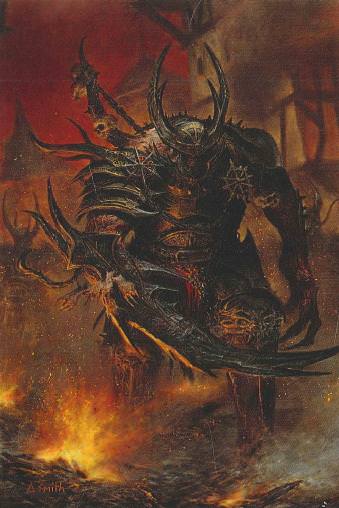


No man amongst Sveinbjorn's hersirs troubled Wulfrik after that, for not a one of them had not borne witness to Fraener's monstrous ability in battle many times before, and the prospect of facing a warrior powerful enough to defeat the fallen Chaos Lord was nothing short of suicide.
The Betrayal. Their newest plan to slay the Champion having failed, Viglundr and Sveinbjorn conspired to instead kill Wulfrik with craft and cunning. Viglundr had manipulated Wulfrik into killing Torgald to pave the way for this new alliance, but the warrior persisted as a thorn in his side. To accomplish this, Viglundr enticed one of Wulfrik's warriors, a Marauder known as Broendulf, to slay the Champion when he least expected.
To Ulthuan. Meanwhile, Wulfrik and the rest of his followers readied themselves to journey to the far off land of the High Elves, known as Ulthuan in the lands of civilized men, but as Alfheim in the tongue of Norsca. A voyage only attempted by the boldest Northmen, such as Erik Redaxe or Magnus the Mad, and always ending in ruin for all of them. Still, the Worldwalker would not be denied, and led his Chaos Warriors to the shores of that enchanted place. Only there, Zarnath claimed, could he summon the magical powers necessary to free Wulfrik from his curse. However, the Kurgan's true nature would be revealed in that place.
The Trap. When they made landfall on the shores of Cothique, Wulfrik and his followers happened upon a group of Elf maidens praying at a monolith. Zarnath warned the Norsemen that the maids were actually witches, and were calling upon strange, arcane forces to smite the invaders and convinced them to kill them. With the dark abandon of their race, the Norscans fell upon the defenseless Elves and slaughtered them gleefully. As the carnage abated, Zarnath mocked the barbarians for their bloodthirsty ways, revealing that the Elf women were not mages, but merely wives who had come to pray to Isha for fertility. He gloated of the horrible vengeance the menfolk of Ulthuan would visit upon them for this act. Zarnath had never intended to free Wulfrik of his curse, only to see him dead in the either the lands of the Chaos Dwarfs, or the High Elves. The deceitful sorcerer disappeared from the scene before the Wanderer could make him suffer for his betrayal, but not before alerting almost every warrior in Cothique to their presence.
The Norscans were then set upon by the Silver Helms and Elven bowmen. Outnumbered, they nonetheless stood their ground and drove the Elves back, denying them vengeance for a time. The Elves had thought that Wulfrik and his warriors would be as easily vanquished as the horde of Erik Redaxe; but the Worldwalker was made of sterner stuff than the vanquished king. Wulfrik even defeated one of the great pale Merwyrms of Ulthuan, bloodying it and causing it retreat back into the deeps. However, the Seafang was smashed to kindling, but the true power of the ship was never in its oars or hull, but it in the figurehead where the daemon magic bound to it was kept. Using its power Wulfrik and the only survivor of his band, Broendulf, managed to escape Ulthuan. Whilst traveling the Border Realm, Broendulf revealed to Wulfrik the scale of Viglundr's treachery and confessed his part in his plans. Incensed, the Champion nonetheless offered a truce with Broendulf until their mutual enemies, Zarnath chief among them, were slain.
Revenge. When the mists parted, the Northmen found themselves in the Empire, for here is where Zarnath had fled to. He was no tribesman of the East, but rather a mage of one of the Colleges of Magic. With the true nature of his enemy revealed to him, Wulfrik traveled back to Ormskaro, to muster such a fleet that would destroy the city Zarnath had fled to. When he reached the great tower of Ormfell, Wulfrik cornered Sveinbjorn and brutally beat the Aesling prince towards an inch of death for his part in the deceit and trickery that had cost him his warriors, and also for forcing himself upon the Sarl Princess Hjordis, whom Wulfrik then repudiated for her weakness in allowing herself to be forced upon.
As Wulfrik prepared to slit Sveinbjorn's throat, Viglundr came upon the scene with a retinue of ironclad warriors and begged Wulfrik to spare Sveinbjorn's life, fearing the retribution of the Aeslings should one of their chieftains die. Wulfrik, now having leverage over the the king, told Viglundr of his plan to plunder far into the Empire, using the Seafang's power to spirit the Northmen beyond the defenses of Marienburg and Nordland. Intrigued by the proposal, Viglundr agreed, though under the agreement that Wulfrik would abandon all designs on the kingship of the Sarls.
Wulfrik agreed, swearing on the Axe of Khorne, and the Norsemen set about rebuilding the Seafang using the wood of the ancient Trolltree, a horrific remnant of the age from before Norsca's settling by the Norsii in ancient times. With the Seafang now rebuilt into perhaps one of the mightiest vessals of Chaos, Norsemen mustered from every tribe to join in this great raid.
The Norsemen soon arrived in Reikland, at the city of Wisborg where Zarnath, known actually as Ludwig Stossel of the Celestial Order, who foresaw his death at Wulfrik's hand, had fled to. Ludwig forsaw his own demise and thus went to great lengths to ensure the death of the Chaos Champion, yet with ever place he sent him to, the Champion only returned stronger then ever. Howling the name of Khorne, the Norscan God of Battles, the Norse warriors butchered their way through the meager defenses of the southling city in berserk rage. Wulfrik did battle with and defeated a powerful Warrior Priest of Sigmar in the siege, thus proving the supremacy of the dark gods of the north over the gods of the south. The baron of Wisborg was also slain, as was his wife, and the entire city was put to the torch and plundered of riches. Wulfrik cornered Stossel in his tower, recognizing the azure glow of his eyes, and fought through all his constructs in order to reach him. The Norseman then subjected Stossel to the torturous death of the Blood Raven, in retribution for the scale of his deceit. His vengeance reaped, Wulfrik still had other debts to pay.
Sveinbjorn's Demise. Wulfrik saw to Prince Sveinbjorn second. The Aesling had attempted to bribe Wulfrik's men into betraying him, promising them a portion of the captured treasure. Wulfrik, having no need for gold, promised his men everything in the Seafang's hold to help him in his own deceit. Wulfrik explained to the trembling prince how he would cut off the chain links connecting most of the other longships to the Seafang, abandoning them there while the Seafang took to the Realm of Chaos. Flying Sveinbjorn's banner on the ship, the tribes would blame Sveinbjorn, not Wulfrik for the betrayal, thus damning the prince's name for all eternity. Sveinbjorn begged Wulfrik to leave him his honor, accepting whatever tortures Wulfrik sought to inflict on him, but the champion was not receptive.
To cap off the revenge, Wulfrik utilized another torture to kill the prince, putting a snake down his throat while he screamed for mercy. When Wulfrik returned to Ormskaro, he threw Sveinbjorn's severed head at Viglundr's feet, his features swollen by the venom of the snake and spoke of how he had left the warriors in the lands of the Empire. Viglundr was shocked, the tribes would now surely descend upon him demanding vengeance for the death and betrayal of their kinsmen. The king pleaded to Wulfrik to aid him again, begging forgiveness for trying to cheat him. Wulfrik laughed at the king's pathetic mewling and strode from the hall, his imagination swimming with the sight of Ormskaro burning and Viglundr dying a terrible death at the hands of the chieftains of the other clans. Viglundr desperately reminded him of Hjordis, but to no avail. He could not have fathomed that Wulfrik had already butchered her before speaking to him.
Ending. Thus did Ormskaro, legendary seat of the Sarl tribes, fall into ruin and destruction. Ironically by the hand of the man the Sarls had reckoned as one of their greatest heroes. This entire adventure had also served to reveal to Wulfrik the truth of his fate: that his curse was in fact a blessing. Without the power of the Seafang, he could not have entrapped schemers such as Viglundr and Sveinbjorn. Without his fame as the Worldwalker, he could not have gained the loyalty of men. Without the lies of Zarnath, the pieces would not have come together. The gods had helped him exact vengeance, and with his faith restored, he would serve them for all eternity as their huntsman. There would be no more attempts to escape his doom as Wulfrik traveled the world, laying low the offerings demanded of him by his gods. Now truly he became the Chaos Gods' most devout servant, and felt their power coursing through him.
Wulfrik the Wanderer
Medium humanoid, chaotic evil
- Armor Class 24 (tower shield, medium chaos armor)
- Hit Points 276 (24d8 + 168)
- Speed 9m.
STR DEX CON INT WIS CHA 26(+8) 20(+5) 24(+7) 10(+0) 13(+1) 21(+5)
- Saving Throws Str +14, Dex +11, Con +13, Cha +11
- Skills Athletics +14, Intimidation +11, Persuasion+11
- Condition Immunities exhaustion, frightened
- Senses passive Perception 11
- Languages Gift of Tongues
- Challenge 21 (33000 XP)
Legendary Resistance (3/day). If Wulfrik fails a saving throw, he can choose to succeed instead.
Gift of Tongues. Wulfrik has the ability to speak in every language to convince worthy opponents into challenging him. Wulfrik can make a Charisma (Persuasion) check with advantage, as a bonus action, against a Wisdom saving throw from the target. If the target fails, it is compelled to fight Wulfrik in melee, taking reckless attacks against him. If it is successful instead, it becomes immune from this feature for the rest of the day. This ability ends when Wulfrik challenges someone else or when the target, or Wulfrik, is killed.
Ultimate Duelist. When Wulfrik challenges a creature with the Gift of Tongues he gains the following benefits when fighting against it:
- He deals an additional 4d6 of damage with every strike landed.
- He scores critical hits on a roll of 19-20.
- He has advantage on Wisdom (Perception) checks to find his prey.
Actions
Multiattack. Wulfrik can use his Slayer of Champions if available and then make five attacks.
Dark Sword. Melee Weapon Attack: +16 to hit, reach 1,5m, one target. Hit: 21 (2d10 + 10) slashing damage plus 11 (2d10) necrotic damage. On a critical hit Wulfrik is healed by a number of hit points equal to the necrotic damage inflicted.
Shield Bash. Melee Weapon Attack: +14 to hit, reach 1,5m, one creature. Hit: 15 (2d6 + 8) bludgeoning damage. If the target is Large or smaller, it must succeed on a DC 18 Strength saving throw or be knocked prone.
Slayer of Champions (Recharge 5-6). For one round, if Wulfrik is engaged in melee in a duel with just one creature, his critical hits inflicts double damage and he rolls attacks with advantage.
Legendary Actions
Wulfrik can take 3 legendary actions, choosing from the options below. Only one legendary action option can be used at a time and only at the end of another creature's turn. Wulfrik regains spent legendary actions at the start of his turn.
Sweeping Attack. Wulfrik performs a spinning attack, he rolls one melee attack for every target in a 1,5m radius around him.
Charge. Wulfrik moves and perform one melee attack.
Collector of Heads (Costs 2 Actions). Wulfrik rolls an attack against a humanoid creature within reach. If the attack lands and brings the target below 0 HP, the creature is killed as Wulfrik cuts off its head.
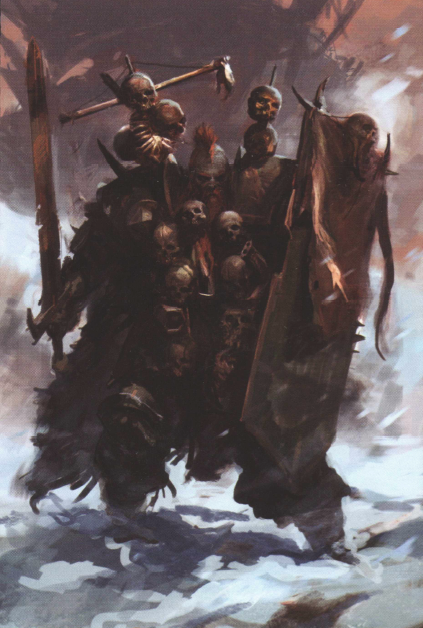



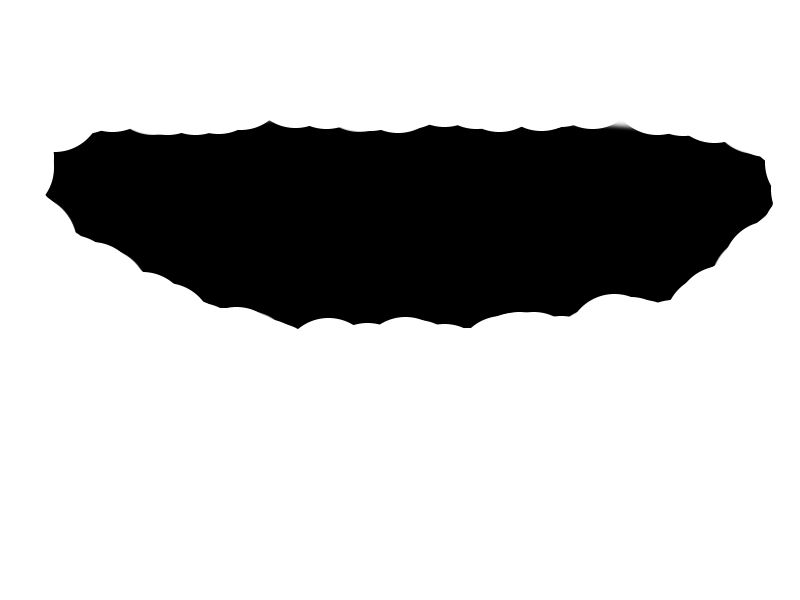
Warhammer's
Guide to DnD.
Norsca